Movie Review By: Mr. Roboto
Year: 2007
Directed by: Michael Bay
Written by: Roberto Orci & Alex Kurtzman (screenplay & story), John Rogers (story)
IMDB Reference
Degree of Cyberpunk Visuals: Medium
Correlation to Cyberpunk Themes:Very Low
Key Cast Members:
- Sam “Spike” Witwicky: Shia LaBeouf
- Mikaela Banes: Megan Fox
- Defense Secretary John Keller: Jon Voight
- Sector 7 Agent Simmons: John Turturro
- Optimus Prime (Voice): Peter Cullen
SFAM Note - Change to Review: CPR now has a number of people doing reviews here. Inevitably, there will be differences over whether or not we think of something as being cyberpunk or not. In the case of the Transformers, Mr. Roboto feels that it is, but I do not (nor do many who listed comments below). I have changed the categories to reflect this (its being placed in the “It’s Not Cyberpunk” category), but the rest of the review is still Mr. Roboto’s.
~SFAM
Optimus Prime: Freedom is the right of all sentient beings.
Overview: Anyone growing up during the mid-80’s must have played with, or at least heard of, Hasbro’s Transformers and watched the animated series that began in 1984. Since then, the Transformers have attained a cult status among nerd types who dreamed of owning a muscle car or heavy duty pick-up that can transform into a kick-ass robot. Now, those fans have a live-action movie to go along with the animated 1986 movie from those heady first-generation days.
I went to see this movie, not expecting cyberpunk themes, but like Optimus Prime and Megatron colliding, BOOM! There they were, though some may say there’s a bit of a stretch for them. Like Alien, there will no doubt be some discussion about the themes and visuals and if the movie qualifies as cyberpunk.
Negative Impact of technology on humanity: Decepticons and the power-hungry Megatron will destroy Earth and the humans for the Allspark, and Megatron even shows his disgust for our species as he flicks a human away during the final battle. Also, the ongoing war between the Autobots and Decepticons could be a metaphoric warning about a possible future “robot war” on Earth.
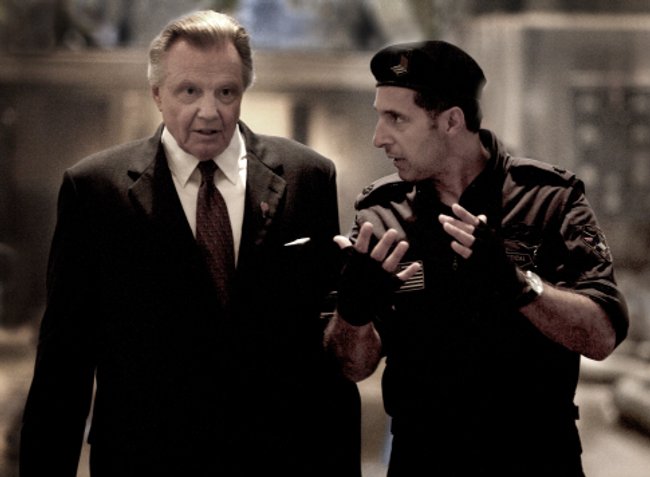
Keller: We’re facing war against a technological civilization far superior to our own! Our enemy can take any shape! They could be anywhere!
Since America’s technology was based on Megatron, leader of the evil Decepticons, it makes our cyber-present sound like it is the seed of evil, forged by evil, for evil purposes. This origin of our technology causes the Allspark to turn ordinary electronic devices into transformer robots that attack humans.
Fusion of man and machine: There isn’t the deep, philosophical aspects of Blade Runner with this theme, but there are signs of lines between man and machine being crossed somewhere between Earth and Cybertron.
At the car lot, Bobby Bolivia (a cameo by Bernie Mac) tells Spike “A driver don’t pick the cars. Mmm-mm. Cars pick the driver. It’s a mystical bond between man and machine.” Spike and Mikaela interact with the Transformers like they were real, even though they’re just CGI animations added afterwards.
The Transformers themselves act sentient, even human like, with their own personalities. Optimus Prime acts like a real leader, keeping trigger-happy Ironhide in check, sacrificing Bumblebee when he’s captured to get to the Allspark, and even plans to sacrifice himself to protect the humans and destroy the Allspark if needed. There’s even dissension among the Decepticons, especially between Megatron and Starscream in their ongoing power struggle since their animated days.
What isn’t clear is if the Transformers were created by organic beings, or used to be organics, but found a way to transfer themselves into robot bodies, or if the Allspark just created the robotic race as the opening narration suggests. I would find it interesting to hear of the Transformers’ origins (creation or evolution?). Maybe a future “prequel” will deal with that.
Control over society: There doesn’t seem to be an “all-controlling entity” present in the film… until Sector 7 enters the scene.
Sector 7 was created by president Hoover when Captain Archibald Witwicky’s Arctic Circle expedition stumbled upon a frozen Megatron to keep the find secret. They reverse-engineered the Decepticon’s technology to create the technology of modern America and her military.
Story focuses on the underground: Mikaela has a juvenile record, thanks to her father showing her how to steal cars. Not much else here. Moving along…
Ubiquitous Access to information: Early on, the Decepticons try to hack America’s military systems, looking for information on the whereabouts of Megatron and the AllSpark. After Blackout’s attack on America’s Qatar base to access the military nets, the Pentagon tries to decipher the signal used to hack the systems. One of the analysts copies the signal to a memory card and takes it to a hacker friend she knows, who succeeds.
The Decepticon Frenzy, who first appears as a boom-box, furthers the hacking cause aboard Air Force One, and succeeds in obtaining information on Sector 7 and “Project Iceman.” He then uploads a virus that causes military systems worldwide to shut down to aid the Decepticon’s attack.
Autobot Jazz: What’s crackin’ little bitches?
Sam ‘Spike’ Witwicky: Where’d he learn to talk like that?
Optimus Prime: We learned Earth’s language through the World Wide Web.
Also, both sides learn of Spike and Captain Witwicky’s glasses from his posts as Ladiesman217 on eBay.

Cyberpunk visuals and style: The desert battle with Scorponok is probably the most cyberpunk visually, with all the sand and the primitive village hosting a high-tech battle between the Americans and a killer robot. There are scenes inside the Pentagon (a cyber-romanticized version) featuring rooms of computers to gather and analyze data. Many scenes take place at night in locations like junkyards and industrial parks. In the final battle in the city, Spike runs through what looks like a long-abandoned rail station. The scenes inside Hoover Dam could be called steampunk.
Do note the color schemes between the bot sides; The Autobots have brigher colors while the Decepticons have darker, militant paint jobs.
A Long Time Ago, In A Galaxy Far, Far Away… (Oops, wrong movie… My bad.) Optimus Prime narrates the opening of the movie; How the Cube of the Allspark gave life to Cybertron (well, ANY planet it came across), and how the evil Megatron tried to abuse its power. The civil war that erupted practically destroyed Cybertron and all life on it, and the Allspark was lost for thousands of years, until it was discovered on an unknown-to-them planet called Earth.
Captain Archibald Witwicky was leading an expedition to the Arctic Circle when he stumbled upon a frozen Megatron and accidentally activated his guidance system, causing the Decepticon leader to imprint the Captain’s glasses with the location of the Allspark. The glasses are now in the possession of his great-great-grandson, Sam “Spike” Witwickey, who is trying to sell them to buy a car.
Sam and his father, Ron “Sparkplug” Witwickey, eventually buy an old Camaro that helps Sam attract Mikalea Banes, who knows her way around cars thanks to her father.

What could be hotter than a babe who knows her way around cars?
One night the car drives away with Sam in pursuit, believing his car was being stolen. The car arrives at a junkyard and transforms into a robot that transmits a signal into space while Sam watches in disbelief. The next day, the car returns and Sam runs believing the car is stalking him. Sam encounters the Decepticon Barricade, in disguise as a police cruiser, who demands the glasses. Sam’s car transforms to fight the Decepticon off, and then reveals his role as guardian before taking Sam and Mikaela to the arriving Autobots and Optimus Prime, who reveals Sam’s connection to the Allspark.
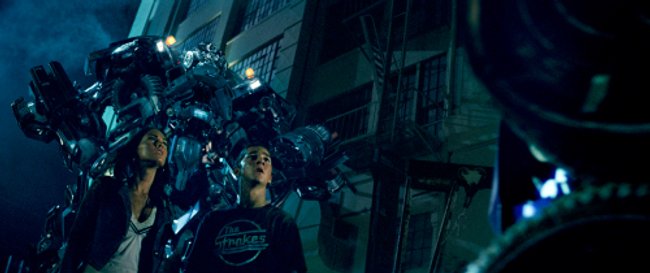
Sam ‘Spike’ Witwicky: It’s a robot. You know, like a super advanced robot. It’s probably Japanese.
What follows is a race to get to the Allspark, followed by a huge city-wrecking mech battle between the deadly Decepticons and the heroic Autobots and American military, including survivors of Blackout’s attack in Qatar.
Robot Apocalypse? We never see the death and destruction of Cybertron, but it wouldn’t be hard to imagine it based on current human events. With two opposing sides fighting over a valuable resource, whether it’s energy or the Allspark, such Armageddons are always possible whether anyone wants them or not. And with the Transformers’ civil war now being played out on Earth, the humans may become unwilling victims of such an Armageddon, especially if the Decepticons win out.
But what about robots the humans will make? Advances in robotic and computer technology have made “human-like” robots more of a possibility in the near future. Future improvements in artificial intelligence can lead to learning machines, machines that can think and act for themselves, and possibly sentience like the Transformers. At that point, our robots may take sides to be human-friendly or anti-human. That could lead to a robotic civil war that could wipe humanity out and leave the planet unlivable, while the robots take their dispute to the stars, possibly destroying other sentient worlds and life forms.
Fortunately, we’re far from that robotic civil war, and the Autobots do keep Earth protected from Megatron’s lust for power and the Allspark. The final lines in the movie are spoken by Optimus Prime as he sends an invitation to his fellow Autobots:
With the Allspark gone, we cannot return life to our planet. And fate has yielded its reward, a new world to call home. We live among its people now, hiding in plain sight, but watching over them in secret… waiting, protecting. I have witnessed their capacity for courage and though we are worlds apart, like us, there’s more to them than meets the eye. I am Optimus Prime and I send this message to any surviving Autobots taking refuge among the stars. We are here. We are waiting.
Conclusion: While geared for the toy-line fans, Transformers does offer something for cyberpunks to think about, whether it was intended or not. There’s little question that it will be this summer’s blockbuster, but some might question if it belongs in the Parthenon of cyberpunk movies.
All I can say is: Do watch it and see if you also notice the cyberpunk themes as I did. It’s OK, it’s a pretty good robot action movie.
Movie Review By: SFAM
Year: 1997
Directed by: Jean-Pierre Jeunet
Written by: Joss Whedon
IMDB Reference
Degree of Cyberpunk Visuals: Medium
Correlation to Cyberpunk Themes: Medium
Key Cast Members:
Ellen Ripley: Sigourney Weaver
Annalee Call: Winona Ryder
Dr. Jonathan Gediman: Brad Dourif
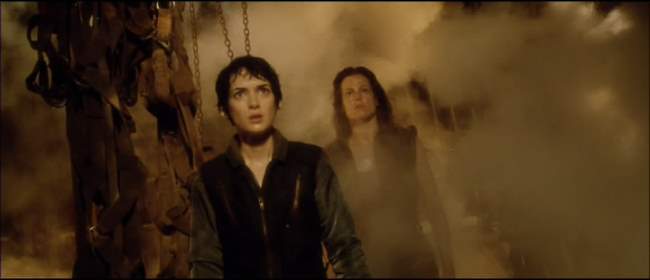
Overview: While Alien 1 and 2 were both stellar movies, the later two sequels definite suffer in comparison. Still, Alien Resurrection provides a significantly different Ripley than is encountered in the first three movies. Ripley is a clone, and an altered one at that. In fact she’s a merging of both the alien and human. With a significantly different approach to visuals and storytelling, Alien Resurrection may not equal the quality of the first two, but certainly can be considered original, which is sometimes a feat in itself for a sequel. The cyberpunk elements, while present, are still sedated, similar to the first Alien (I don’t really consider Alien 2 or 3 to have enough to consider them cyberpunk).
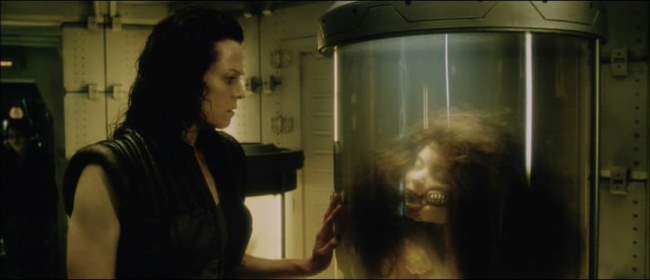
The Story: Two hundred years after her death, Ripley (Sigourney Weaver) has been cloned for the purpose of giving birth to the Alien Queen inside of her at the end of Alien 3. It’s not the corporation this time, instead it’s the good ‘ole government. While it’s never really fully explained how the melding of the two came about, you basically have to “roll” with it if you want to enjoy the movie. In any event, Ripley somehow survives the birth of the Alien, and is kept alive for “study” purposes.
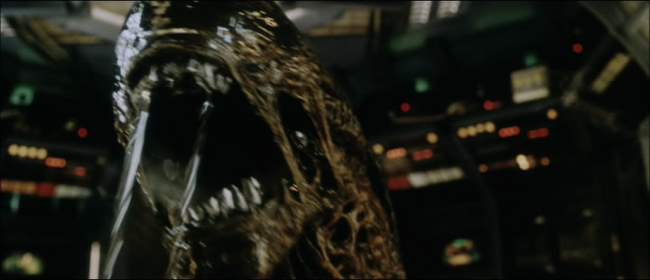
Meanwhile, the Alien Queen that Ripley births requires hosts for her eggs. Enter a group of mercenaries led by Elgyn (Michael Wincott). His group also includes Winona Ryder, Dominique Pinon, Ron Perlman, Gary Dourdan, and Kim Flowers. The mercenaries have captured a ship full of people in suspended animation, and have brought the victims to the military research ship for money and other goodies (including a few days sleep in a regular bed). Things go bad when fanatatical crazed head scientist, Dr. Jonathan Gediman (Brad Dourif) makes the mistake of leaving three of the Alien births in the same cage. Two of the aliens kill the third, who’s acidic innards then create a hole in the floor, thus forming a jail break. From there, its on – aliens are in control and have a field day in eating up the poor humans who can’t escape on time. But unfortunately for the Queen, her DNA has been melded with Ripley’s and her second generation offspring has turned out differently than intended.
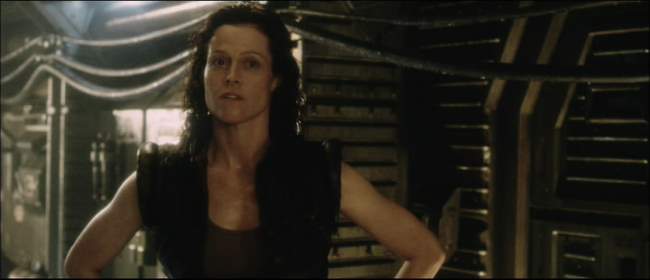
Ripley is Different in Resurrection: In Resurrection, we don’t get the tired, beaten down Ripley from the previous two movies who somehow manages to persevere and survive. Instead, Weaver takes to her genetic change with a gusto that mixes just the right mix of alien swagger, camp, and tender humanity. Most importantly, Weaver doesn’t take herself too seriously here. Ripley’s smirks more than anything else make the impossible set-up bearable. Its almost as if she’s saying, “Yeah, this is Frankenstein 4, but you knew the monster (me) needed to come back from the dead if there was to be a sequel, right? Just roll with it and we’ll be OK.” In short, Weaver almost single-handedly makes this sequel work. Ripley’s one liners (such as, “Who do I have to fuck to get off this ship?”) sometimes even come close to equaling those in Aliens. However, this approach can only go so far - if they ever plan on doing an Alien 5, they’re gonna need to revive Abbot and Costello!
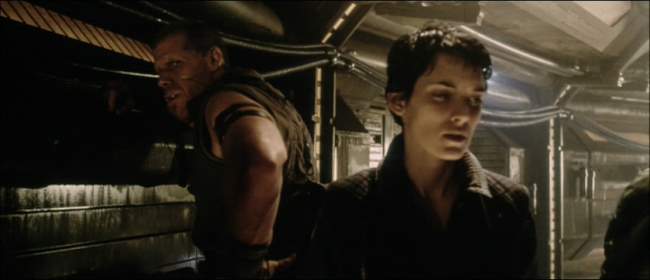
The Rest of the Cast: While Weaver shines, the same cannot be said of the rest of the cast. Some of the member are really hit or miss, while others fail altogether. Winona Ryder’s role was a bit too much for her to pull off. First she had to be a believable mechanic (Kaylee, she’s not!), and then had to be an undercover resistance member and finally had to work as a {SPOILER – highlight to read} second generation android. I don’t know who could have worked all three of these aspects into a coherent whole, but Ryder was not able to pull it off. Although, Ryder does shine in some of the scenes – especially those that are similar to Ripley’s role in the first movie where the Ryder is struggling to maintain sanity when everything is stacked against them. For other examples, Brad Dourif as the crazed scientist is too over the top, and Dan Hadaya as the military commander comes off as a complete imbecile. Two notable standouts are mercenaries Ron Perlman and David St. James – both turn in very solid and interesting performances.
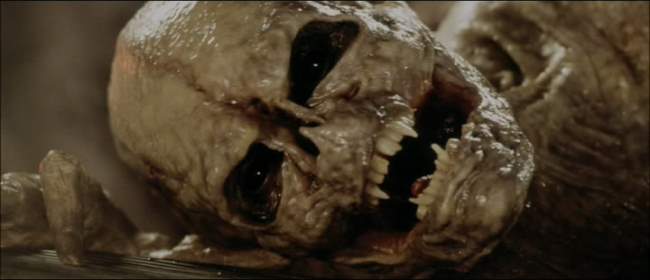
The DNA Mixing: OK, the DNA mixing explanation is just too hokey to work. Joss Whedon deserves some credit for at least not running away from this impossible task – instead he makes it a centerpiece to the story (but it still doesn’t’ work – then again, I don’t think anything would). Basically they needed a way of both recreating Ripley will still keeping her memories intact. Their work-around is to state that Ripley’s and the Alien’s DNAs melded together (I suppose this happened in the lava? Good thing they were able to retrieve it, ey?). OK, fine, but I have a few questions: Aliens are uniquely different from humans but their DNA is so close that its not distinguishable form one another? Or assuming the DNA was melded, how exactly did they know what they were looking at? More to the point, how did they figure out (even with lots of trial and error) to make two completely separate organisms out of the DNA? But even taking the ocean of salt needed to buy that explanation, how is it that an alien organism who grows by eating the material in the lungs is able to read Ripley’s memories and retain them? Again, while this clearly is problematic, you really just have to roll with it if you want to enjoy Resurrection.
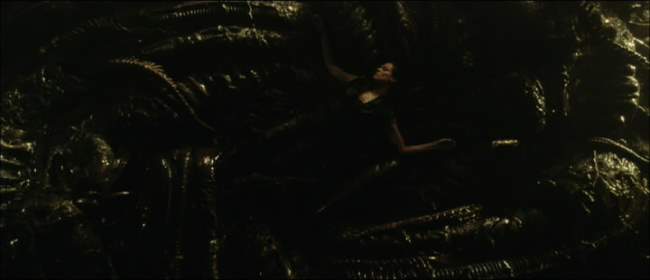
Genetic Manipulation Scare: Probably the scariest aspect of Alien Resurrection is the notion that in the semi-near future, genetics will be advanced enough and so well understood that even your basic crackpot scientists with the right equipment can play Josef Mengele in experimenting with mixing lifeforms to their hearts content. One can imagine a number of variations to this, but the jist of the concern is that its not too far a stretch to imagine that in the near future, less savory governments or corporations may be lured to do various genetic trials of this kind in the pursuit of fame and profit. This concept in Resurrection is as cyberpunk as one can get.
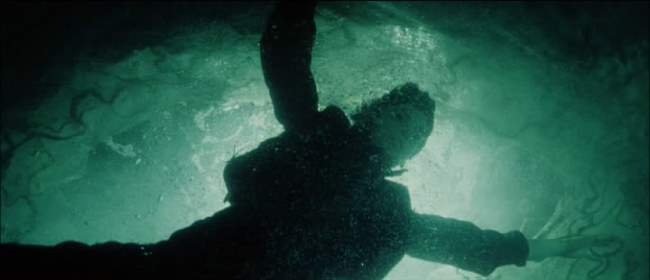
The Android: Unfortunately the back story is glossed over, but in Alien Resurrection, the androids have somehow developed a second generation android, one who is not beholden to human command. Not surprisingly humanity targeted them for termination, which caused the remaining second generation androids to burn out their communications devices and go into hiding. In Alien Resurrection, it’s the android who holds the tenets of humanity most dear. The android is more concerned with the fate of mankind than all the shallow and flawed humans in this movie. The android is even religious. One wishes this aspect of the androids was explored. If they truly feel that they indeed have a purpose for existence, how is this rationalized, and how have they changed the concept of a human deity to accommodate their self-worth?
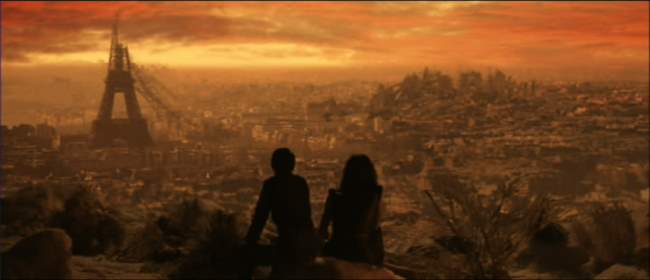
The Visuals: Director Jeunet and visual effects supervisor Pitof deserve credit for creating some wonderful visuals in Alien Resurrection. Resurrection contintually treats us to some wonderfully composed shots – shots that far exceed the qualities of the acting. Even if the plot and acting turn you off, the cinematography, wonderful set pieces, models and creature FX will help keep Alien Resurrection bearable. Like many cyberpunk films, a single color dominates the film – yellow in this case. Yes there are some blacks, but yellow seems to permeate all the key scenes.
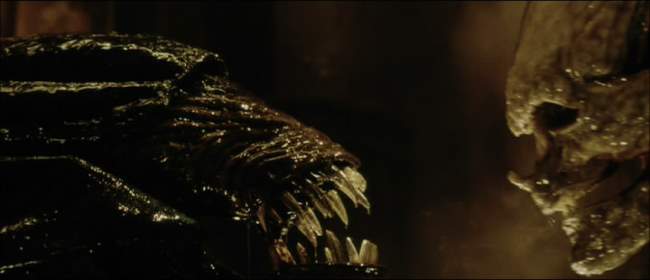
The Bottom Line: Yes, Alien Resurrection has an extremely problematic story within a flawed movie, but it ends up being more fun than it probably deserves. Even though the rest of the cast doesn’t always support her, Sigourney Weaver turns in a terrific performance. This, along with the originality, the wonderful cinematography and FX make Alien Resurrections a step up from Alien 3, and worthy enough to watch. While the cyberpunk elements are subdued, the android along with the genetics and dystopic civilization (destroyed by human wastes and technology) are enough to include it in this site. Alien Resurrection won’t flip your world like the first two did, but its still worth a watch.
~See movies similar to this one~
Movie Review By: SFAM
Year: 1997
Directed by: Luc Besson
Written by: Luc Besson & Robert Mark Kamen
IMDB Reference
Degree of Cyberpunk Visuals: High
Correlation to Cyberpunk Themes: Low
Key Cast Members:
Korben Dallas: Bruce Willis
Leeloo: Milla Jovovich
Jean-Baptiste Emanuel Zorg: Gary Oldman
Father Vito Cornelius: Ian Holm
Ruby Rhod: Chris Tucker
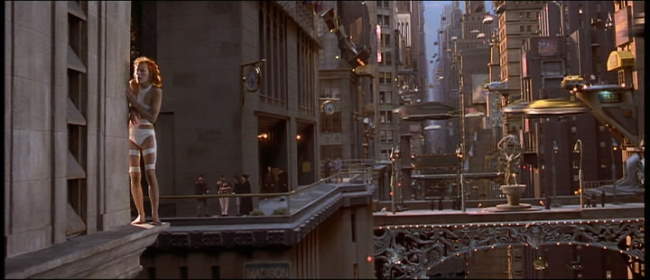
Overview: Some movies are just absolute absurd fun – so fun that you end up watching it endlessly. The Fifth Element is that way for me, and is a movie I’ve seen around 20 times or so. The tone of the movie is too light-hearted to be considered a real cyberpunk movie, but like Tank Girl, we can consider this a cyberpunk comedy. The characters are all a hoot, and the movie never takes itself seriously – in fact it’s almost always over the top. Many of the cyberpunk themes still exist in Fifth Element, although, again, they are enacted in a light-hearted way. It’s the visuals that really bring Fifth Element into the cyberpunk subgenre.
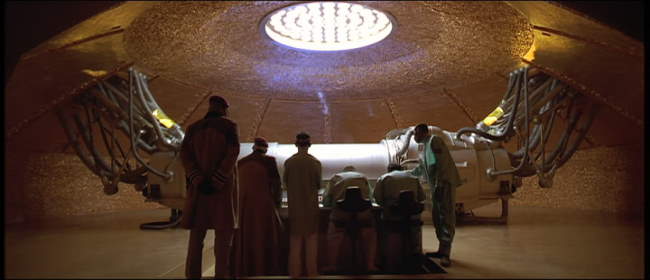
The Story: 217 years into the future, ultimate evil is again coming to destroy the earth. Ultimate evil takes the form of an absolutely massive malevolent ball of blackness that is on a course to destroy earth. Every attack the Federated Territories try only makes it larger. It turns out that a group of priests has been keeping the ancient technology necessary to destroy ultimate evil – four stones representing the 4 elements, which surround a fifth element. In this case, the fifth element is s beautiful girl (Milla Jovovich), reconstructed from the remains of a small DNA sample.
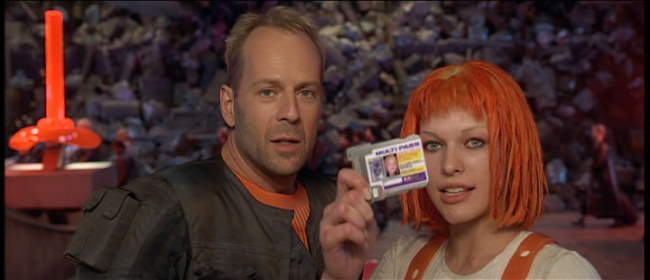
“Leeloo Dallas, Multi Pass”
Korben Dallas (Bruce Willis) is a down and out highly decorated former military commando, now turned failing cabbie, who has a beautiful girl named Leeloo (Jovovich) fall into her cab – literally! The authorities are after her, as it turns out she has escaped those who recreated her. She can’t speak English yet she figures a way to ask for help. After she asks, Korben Dallas takes her to the priest, Father Vito Cornelius, who recognizes her as the Fifth Element, and promptly kicks Korben out.
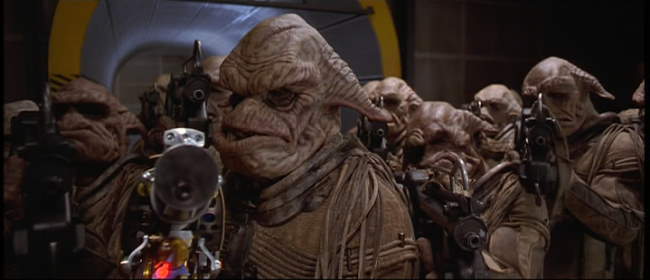
From there, things get crazy. The military approaches Korben for a secret mission to retrieve the stones necessary to stop ultimate evil. The stones are hidden with a famous Diva who is performing at the famous floating hotel, Floston Paradise. At the same time, Zorg, an evil corporate CEO (Gary Oldman) has hired a group of Mangalores (evil, ugly aliens) to retrieve the stones. Simultaneously, Father Vito Cornelius and Leeloo also find a way get to Floston Paradise to retrieve the stones. Things get even weirder when the famous radio host, Ruby Rhod (Chris Tucker), an outrageous guy with a penis-head hairdo hosts the Floston Paradise experience with Korben as his guest!
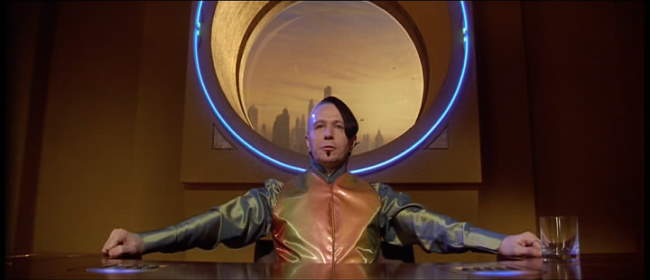
The Acting: All the main characters in the Fifth Element are quirky and memorable. Bruce Willis really works as a former hero, now on his last leg. Jovovich is beautiful and otherworldly. Tucker is a riot! This movie really got him known (Rush Hour made him famous though). And Gary Oldman as Zorg is flat out awesome as a completely crazed power-hungry evil doer with a quirky sense of style and salesmanship. Truly, Besson did a great job in casting this.
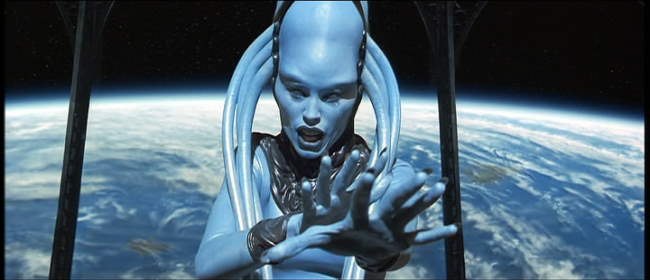
The Visuals: The Fifth Element totally rocks in the cool futuristic visuals department. The colors include dark yellows with neon blues for the backgrounds, saturated blue scenes and orange clothes for the leads. But its the city-scapes, reminiscent of Lang’s Metropolis that are especially memorable. They flat out nail a far out vision of the future. Additionally, we have airports with 30 foot tall trash heaps due to a garbage worker strike, fully automated, ultra-processed McDonalds, deaf rock stars
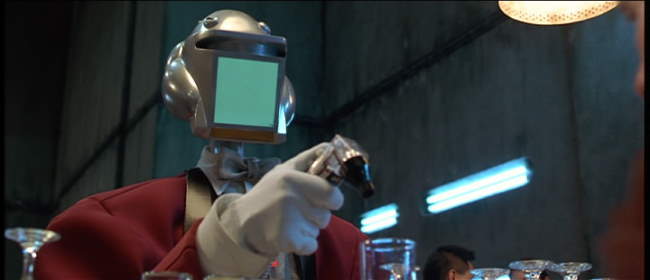
The Editing: The editing in the Fifth Element is just terrific. The splicing of the various story strands, as crazy as they are, flow wonderfully. In discussing the missing stones, the simultaneous, intermixed dialogue between Leeloo and Father Cornelius and Zorg with the Mangalores are just one terrific example of this; the Diva opera singling intermixed with Leeloo’s fighting is another. With the amount of stuff going on here, this could have ended up a disaster. Sylvie Landra, who also edited Leon – the Professional, deserves heaps of praise for this.
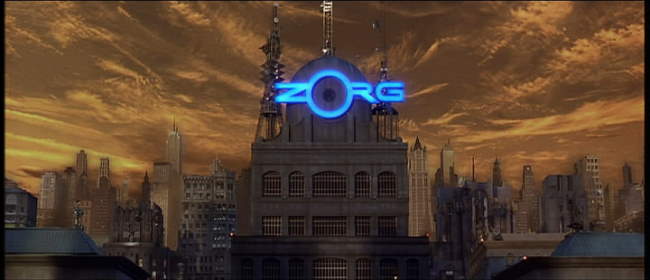
The Fifth Element Cyberpunked Future: Dropping the crazed fantasy aspects of the stones and ultimate evil, The Fifth Element gives us a pretty dire view of the future. Cities are built high to escape the constant layer of smog that coats the surface; corporations are all-powerful; governments are impotent; fashion statements have gone seriously awry; cockroaches are used as intelligence, surveillance and reconnaissance systems - but at least we still get cheap Chinese food! Plus robots now do all our menial work!
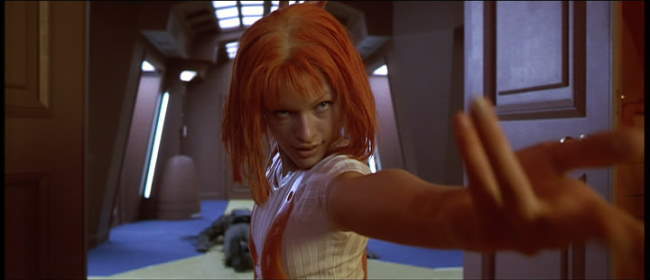
The Bottom Line: No, the Fifth Element is not intended to be taken seriously. Still, this movie is just far more enjoyable than it has any right to be. The action and romance are fun, the characters are unforgettable, the story is entertaining, the music is great, and the visuals are marvelous! The Fifth Element has been in my regular heavy watching rotation since it came out. Give this a watch if you’re looking for a witty futuristic cyberpunk action-comedy flick.
Go to Page 2: More Fifth Element Screencaps–>>
~See movies similar to this one~
Movie Review By: SFAM
Year: 2002
Directed by: Gary Fleder
Written by: Philip K. Dick (story), Scott Rosenberg (Adaptation), Caroline Case et a. (screenplay)
IMDB Reference
Degree of Cyberpunk Visuals: Medium
Correlation to Cyberpunk Themes: Medium
Key Cast Members:
Spencer Olham: Gary Sinise
Hathaway: Vincent D’Onofrio
Maya Olham: Madeleine Stowe
Cale: Mekhi Phifer
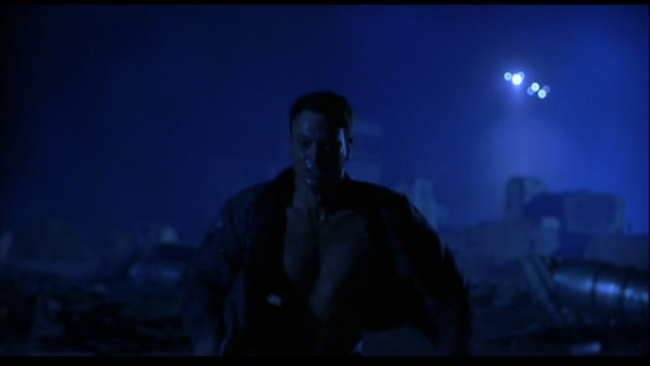
Overview: Impostor got bashed by critics for having bizarre cut always, too many slow motion scenes, and generally weird and herky-jerky cinematography decisions. Additionally, others criticize it due to originally being a 30-40 minute short that got extended into a full-length movie. While all true, I truly like both the story (basically the Fugitive, done in a near future setting) and the acting, especially by Gary Sinise and Madeleine Stowe. While the cinematography is definitely subpar in this Philip K. Dick story, the movie itself is still worth a watch.
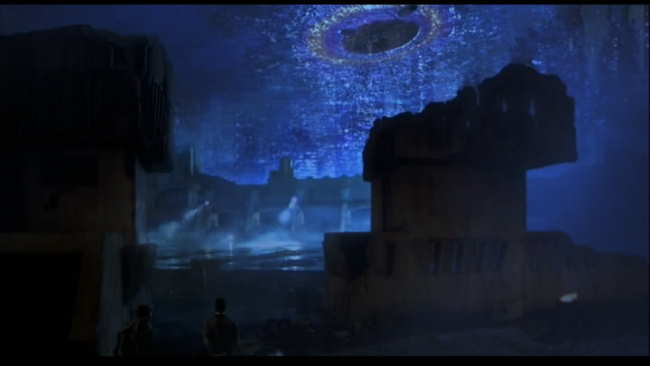
The Story: Impostor is set in the year 2079, a time when a race of aliens are attempting to invade the earth. To protect the population, humans now live in high-tech “bubbles” which seem to be able to keep out Alien weapon systems. Because of this, the aliens have resorted to creating DNA-based replicants, not unlike those in Battlestar Gallactica, by a process which apparently involves copying captured humans. These replicants are in actuality very powerful bombs, but have no self-awareness of being replicants – when their “trigger” is invoked (such as being in close proximity to their target), they explode.
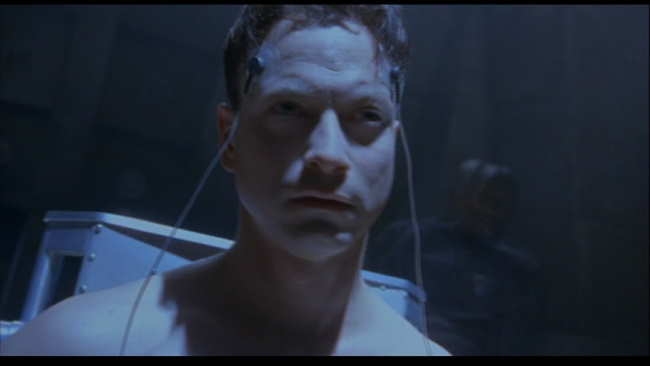
Sinise plays Spencer Olham, a weapons scientist who has been accused of being replaced by a replicant (called a cyborg in the movie). The security head (Vincent D’Onofrio) captures him and threatens to rip out his heart in order to prove that he’s not a human. Sinise escapes and then engages on a journey to prove his innocence. Olham determines that he can prove his innocence by equipment at the hospital where his wife (Madeleine Stowe) works, that compares a previous body scan with his current body. Unfortunately, he’s already gotten out of the city, and now needs to figure out how to get past security to return.
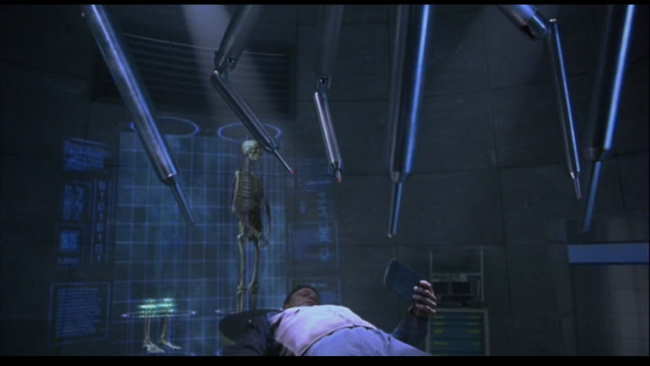
How Do You Know You’re You? This, in essence is the question Impostor is asking when it’s not in chase-filler mode. Is Spencer Olham a human caught in a horrid mistake, or is he a cyborg comprised of human-like bio-matter that is in actuality a powerful bomb sent by aliens to infiltrate Earth’s defenses in order to kill human leadership? If you were a cyborg-replicant imbued with the memories of the original host, how could you figure it out? Imposter briefly mentions the notion that the cyborgs don’t have a soul, but this is never pursued. One wishes they had come up with some way of quantifying a soul. But in the end, we are left to answer this question ourselves.
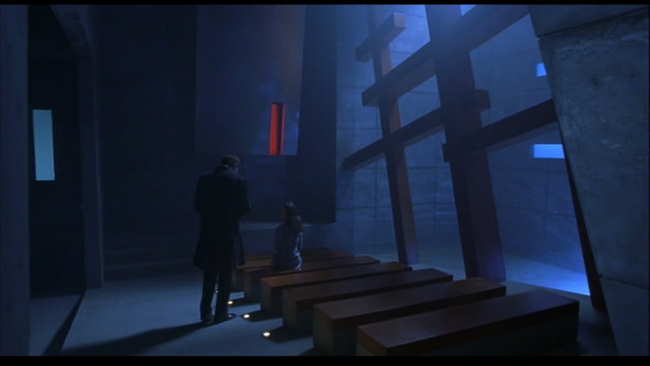
The Middle “Chase” scenes are Filler: Originally, Impostor was shot as a 30-40 minute movie short that was intended to be part of a larger collection. Apparently, Miramax liked the short enough (or cooled to the short collection idea) that they wanted it extended into a full length feature film. However, in doing so, they were left with a relatively tight beginning and tight end, and then a vast chasm of nothingness in the middle. By and large, the middle is filled with semi-pointless chase scenes that are sprinkled with people that aren’t germane to the central plot. Now we get a whole underground dystopia thing added to the mix, whereby it turns out that the nice hospital is ONLY for those who live in the bubble, while those in the outer area get little or no medicine and support. In its better moments, the middle part of the movie seems to want to emulate a “Fugitive” type feeling, but this doesn’t always work well. The DVD also includes the original movie short which is definitely worth a watch.

The Visuals: Impostor’s vision of the future is terrific in some places and haphazard in others. The cityscape scenes look right out of blade runner, the bubble city coverings, torture look great, but the majority of Imposter involves treks through regular looking tunnels. The torture equipment and medial imagine equipment are both more than passable. Imposter is strongly dominated by blue tones, which pervade most every aspect, from the chase scenes to the interrogation scenes.
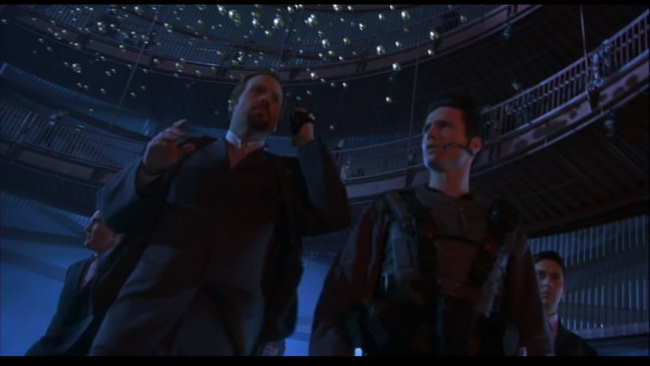
The Acting: By far, the best aspect of Impostor is the acting.Gary Sinise in particular really sells his role well, but Madeleine Stowe and Vincent D’Onofrio also give high quality performances, and Mekhi Phifer is at least passable. With slightly worse performances, Imposter could have easily ended up in the cheesy “B” Movie bin. The effects are uneven enough (some looked great, others looked TV-ish) that solid acting was a must to keep this movie watchable.
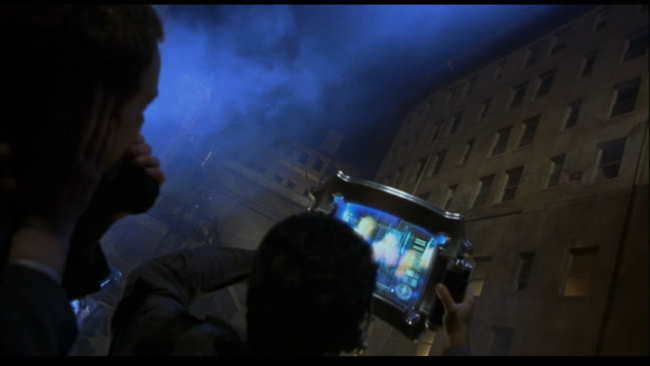
The Editing: Impostor is rightly criticized for crazy and continuous cut-shots. Rare is the shot that lasts more than 4 to 5 seconds before cutting to another view. The goal was to add to the tension of the chase scene, but the editors went overboard. Especially when combined with some strange shot angles, Imposter almost takes on an experimental vibe, as if they weren’t sure what would work, so they tried various different things.
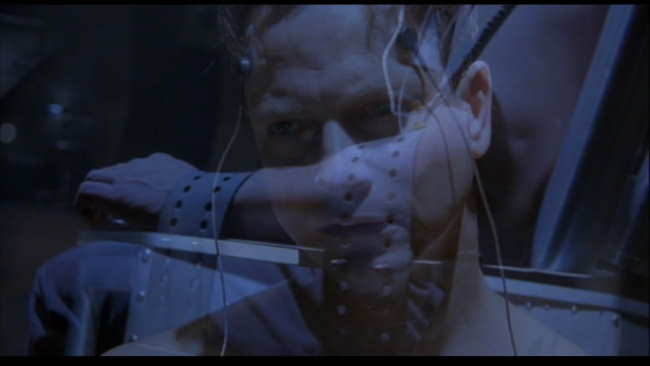
The Bottom Line: While this “Fugitive-like” movie has lots of interesting scenes, it’s the ending that I really like - definitely a cool twist. The acting is solid and the visuals are sometimes, but not always, pretty decent. There are lots of pointless tunnel-running that easily could have been cut by 15-20 minutes, and also, there are enough questions and plot holes that stop Imposter from being a great movie. Still, the question of determining humanity is an interesting one, and is well executed.
~See movies similar to this one~
Movie Review By: SFAM
Year: 1981
Directed by: Gerald Potterton, Jimmy T. Murakami
Written by: Len Blum et al.
IMDB Reference
Degree of Cyberpunk Visuals: Medium
Correlation to Cyberpunk Themes: Low
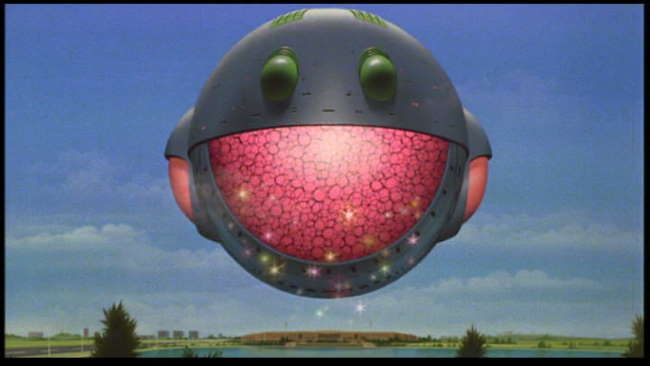
Overview: Heavy Metal represents one of my great teenage film memories. Back in the day, before the porn repository known as the internet was formed, Heavy Metal was edgy stuff. As a young teen, Heavy Metal was everything a kid my age wanted to see – sex, drugs, rock-n-roll, violence, defiance of authority, and hot chicks! Add the most awesome hard rock soundtrack, and Heavy Metal became the drug of choice for young folk back then. That it was animated somehow made it alright with the parents. Make no mistake – Heavy Metal is not high brow fare, nor is it particularly well made. But it is definitely a very fun guilty pleasure.
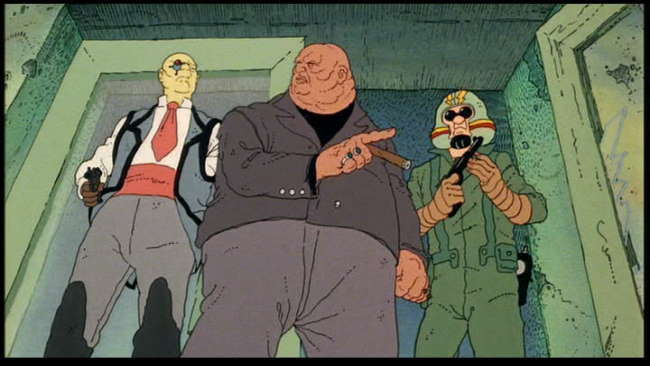
The Story: Heavy Metal is a series of somewhat interrelated vignettes about the journey that ultimate evil makes, this time in form of an evil sentient green orb, called the Loch-Nar. The Loch-Nar captures a little girl in present times for reasons unknown till the end, and shows her a series of stories about how the Orb has corrupted people of all races in all times and places.
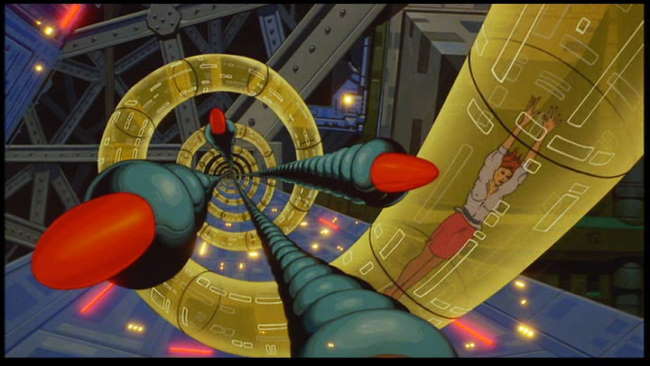
In each story segment, we get a strange, otherwordly setting in which the orb enters, corrupts and then leaves. Often a hero stops the orb from fully corrupting everything, but always the orb leaves a stain. The atmosphere is one of interrupting and ongoing scene with something truly unusual that occurs. But it’s the ending vignette, Taarna which is the best, and also the one that finally gives us insight into why the Loch-Nar has captured this little girl. Taarna isn’t really cyberpunk in any way but a few of the visuals, but it is a lot of fun.

Is it cyberpunk? Clearly, some of the vignettes, many in fact, are more fantasy than cyberpunk. So why do I have this movie listed? While some of the vignettes do have the cyberpunk feel, most clearly Harry Canyon, Heavy Metal absolutely belongs here due to its magazine roots. Both William Gibson and Ridley Scott credit visuals in the Heavy Metal Magazine is very influential for helping create their settings. Most cited is the Moebuis illustrated “The Long Tomorrow” comic. As you can see by the link, the Long tomorrow gives us a gritty neo-noir, near future comic that’s edgy, dangerous, and lots of fun. And more importantly, the atmosphere – the mood in Heavy Metal throughout seems pretty cyberpunk.
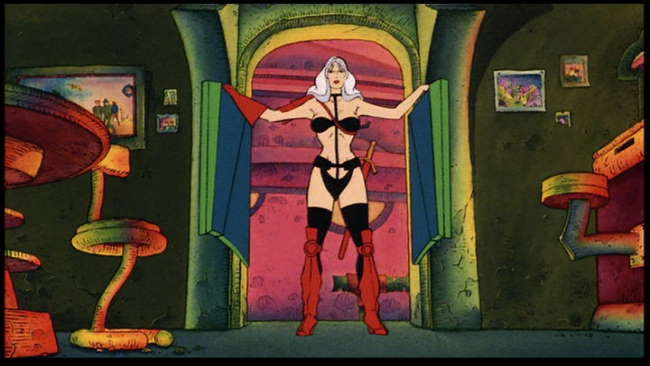
Heavy Metal is Male Fantasy Material: Heavy Metal is NOT sophisticated - far from it in fact. Heavy Metal caters to the sophomoric, prepubescent male, and emphasizes gratuitous nudity, hot chicks kicking butt, nerds who grow massive bodies and get laid, android-hot chick sex, etc. Heavy Metal falls right in line with the old “Gonad the Barbarian” style books, so in this way, it really isn’t cyberpunk. Cyberpunk as a sub-genre dramatically improved the quality and intelligence of what we found on the scifi-fantasy shelves. Heavy Metal the movie does not, although many of the stories do provoke an interesting thought or two.
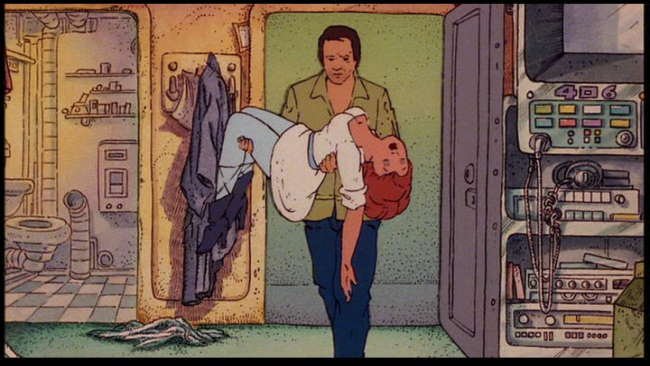
The Animation: Each story segment is written and animated by completely different teams, although some of the voice actors such as John Candy appear in many episodes. Some of the segments seem pretty simple, whereas others have more than decent texture. All in all, Heavy Metal represents a mixed bag, but at the time, it truly was on the revolutionary side. While French director René Laloux’s most awesome animated movies were far better, outside of them, few things touched Heavy Metal. The fact that Heavy Metal included the themes and visuals teens were looking for back then transformed it into the ultimate cult rebellion flick.
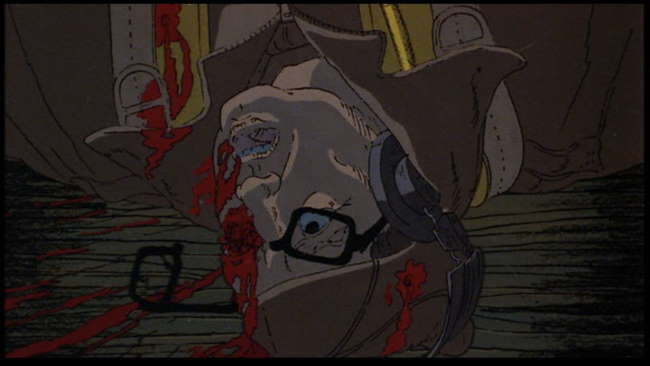
The Sound Track: Heavy Metal still should be considered among the best sound tracks for a movie. It SOOO added to the atmosphere. We get a heaping dose of great hard rock from the likes of Blue Oyster Cult, Black Sabbath, Sammy Hagar, Cheap Trick, and Don Felder’s most awesome rendition of Heavy Metal (Takin’ A Ride). In addition, we get great little 80s tunes like Devo’s “Working in a Coal Mine,” Journey’s “Open Arms,” and Stevie Nicks’ “Blue Lamp.” Truly, if you’re interested in experiencing 80s counter-culture at its fantasized finest, Heavy Metal is the movie to watch.
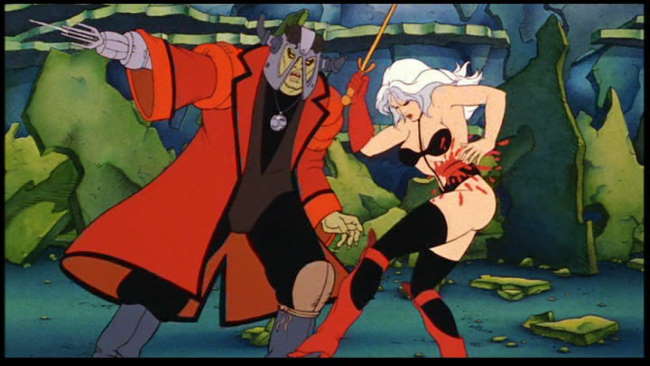
The Bottom Line: Heavy Metal is not a great movie, but it is a lot of fun. While it has a few vignettes that are clearly cyberpunk in nature, the majority of the movie is unsophisticated SciFi-Fantasy. Still, the visuals and atmosphere are more than interesting, as are the diversity of animation styles. Heavy Metal should be seen more for the vision this film represents from the Magazine. This, as much as anything is responsible for the genre we now call cyberpunk.
~See movies similar to this one~
Movie Review By: SFAM
Year: 2001
Directed by: Steven Spielberg
Written by: Brian Aldiss, Ian Watson & Steven Spielberg
IMDB Reference
Degree of Cyberpunk Visuals: Very High
Correlation to Cyberpunk Themes: High
Key Cast Members:
David: Haley Joel Osment
Gigilo Joe: Jude Law
Monica Swinton: Frances O’Connor
Prof. Hobby, the Visionary: William Hurt
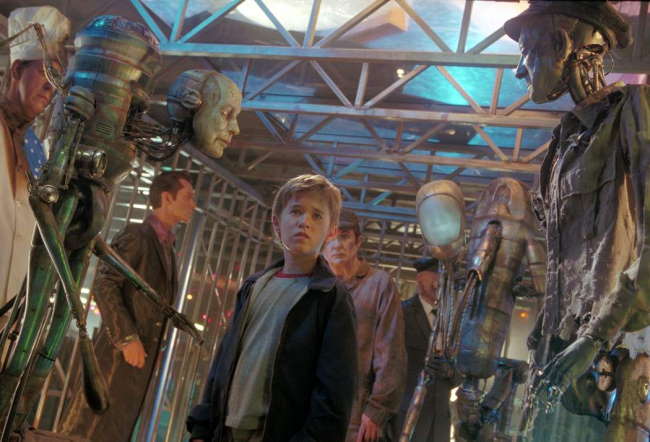
Overview: Originally convieved of by Stanley Kubrick, Spielberg took the reigns of this wonderful Pinocchio tale done in cyberpunk. This story is about a robot who wants to be a “real boy” so that his mother will really love him. Like Pinocchio, he goes on a journey of discovery. Although there are a few over-the-top scenes, the FX is awesome and the acting is wonderful. AI definitely inspires discussion if nothing else.
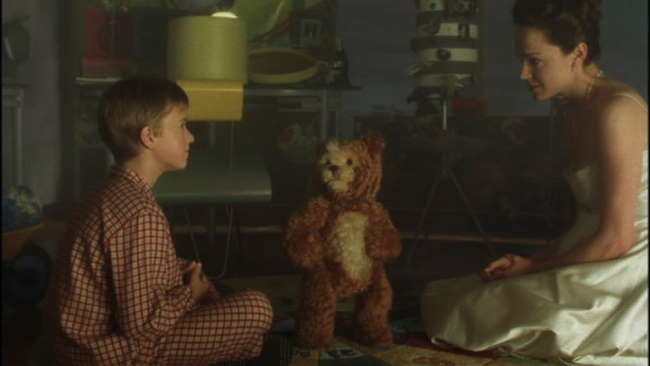
The Story: Set in a near future where global warming has led flooding of all the coasts, and a general breakdown has occurred in many parts of the world. Robots, called Mechas, are common in society now, and perform a variety of functions. Unfortunatley, there is widespread public outcry against their very existence. The focus is on a single family, where a mother has essentially lost her son, who now hangs on to life in cryogenic freeze. Her husband convinces her to get a new model mecha to replace their son – this one becomes hard-wired to its owner and experiences real love and emotion. After accepting their new mecha, a child named David, the family’s life seems complete – until their real son miraculously recovers from his illness.
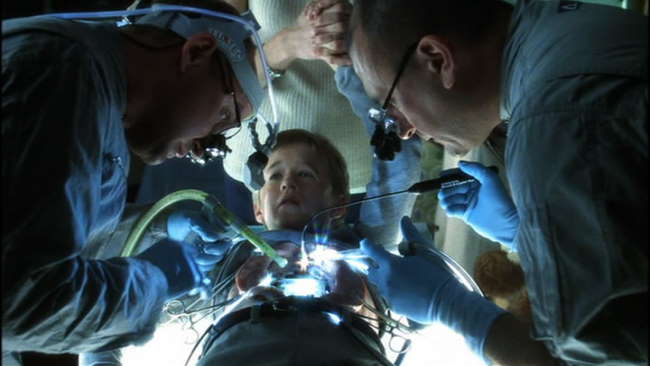
Their real son feels threatened by David, and after a sequence of incidents, David’s mother is forced to send David back to his maker for destruction. But while driving him to his death, she cannot bring herself to follow through, and instead sets him free. In a traumatic breakup, David’s mother warns him of the dangers of the outside world before leaving him alone with just his Teddy toy. David, having been read Pinocchio, decides that if he can find the Blue Fairy, he can convince her to turn him into a “real boy.” Along the way, he encounters Gigilo Joe, who helps him on his journey.
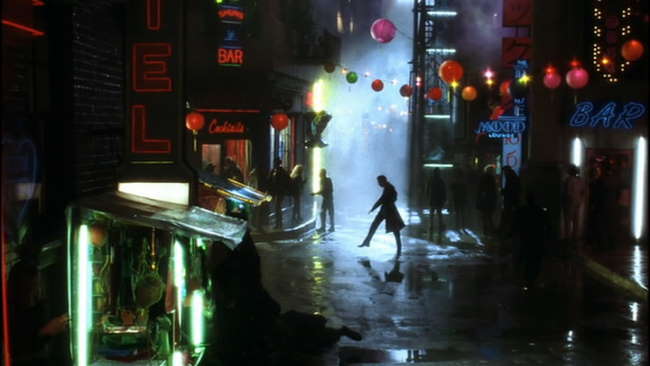
The Acting: The acting in AI is consistently terrific. Haley Joel Osment puts in a performance you’d never expect to see from an actor so young. He is utterly believable both as a mecha, and as his journey proceeds, seemingly transforms into a regular acting boy. Jude Law puts in a terrific performance as Gigilo Joe – one that almost transcends the movie itself as a memorable character. Frances O’Connor also delivers a fine performance as David’s mother, as does William Hurt as David’s inventor.
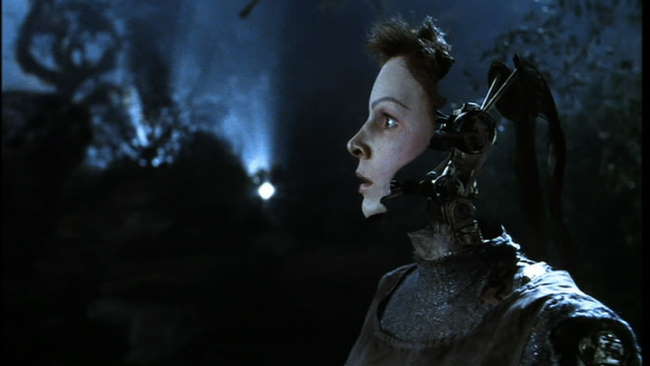
The FX: The visual effects in AI are still among the best that’s ever been put on film. The mechas (robots) look incredibly real – far more real than should be possible. There are many different kinds of mechas, many of which are represented here, but none are better than the Nanny. She is breathtaking. The entire front-end of the movie gives us a very normal set of surroundings. Other than the cars, and minor mecha parts, we aren’t dazzled by the upfront effects. This makes the second half all the more impressive. When David goes outside, things change dramatically. From the robots, to the city-scapes to the destroyed New York, this AI is a visual feast. To top it off, the Teddy Bear is maybe my favorite robot character of all movies.
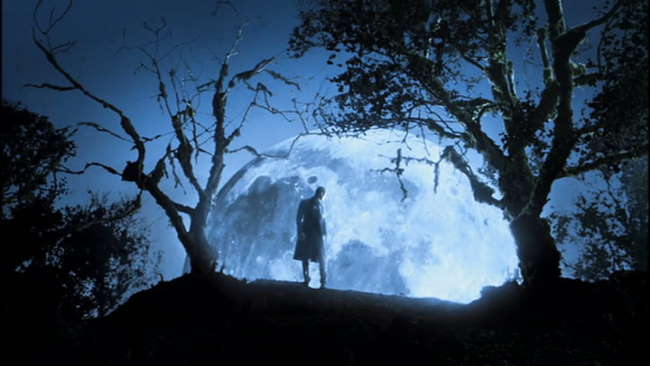
The Score: John Williams is as awesome as ever in creating the score for AI. He is able to capture the feeling of the dregs of humanity along with an almost heavenly sense of love and contentment. The score really brings the movie together in places that with something lessor it might not have worked.
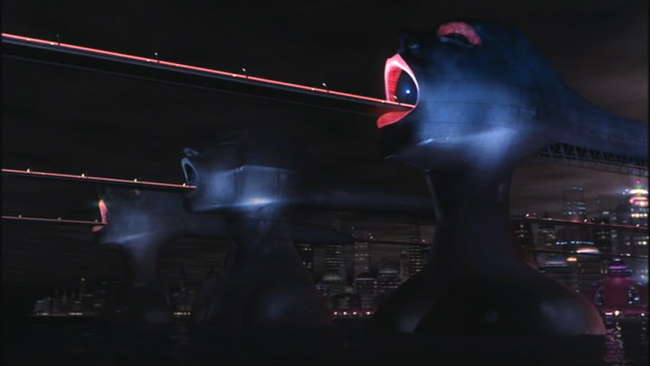
Kubrick versus Spielberg: AI is a strange movie in that it encapsulates a harsh Kubrick-style future while at the same time has a story that lends itself to Spielberg’s Capra-like tendency for the emotional mushiness. In watching AI, rarely do the two tendencies meet up well. We either have the dystopic craziness of the Flesh Fair or the serenity of the beginning. We also see dramatic changes in pacing. In some parts, we have a very slow, deliberate movie, whereas in others, it seemingly breezes past key scenes.
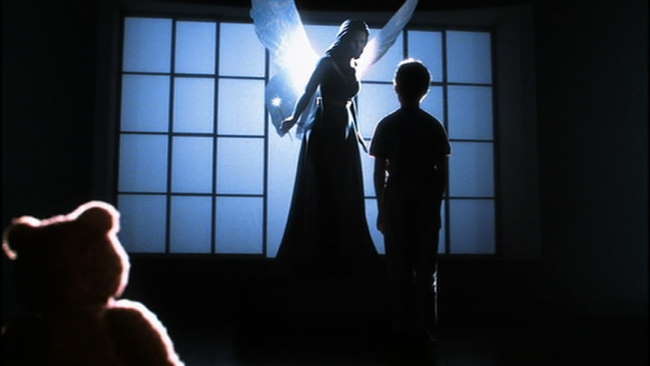
Some thoughts on the ending: Many folks who generally like the movie end up hating the ending. I don’t have this issue - in fact I like the ending, but I do understand the sentiment. The ending really does drop into a completely different movie altogether. In effect, it becomes the fairy tale that David pursues the entire movie. But because I KNOW the ending engenders discussion, I am concerned about spoilers in the comments below. PLEASE don’t post spoiler thoughts - if you do, your comment will be deleted. Instead, I’ve created a thread in the meatspace to discuss the ending of AI.
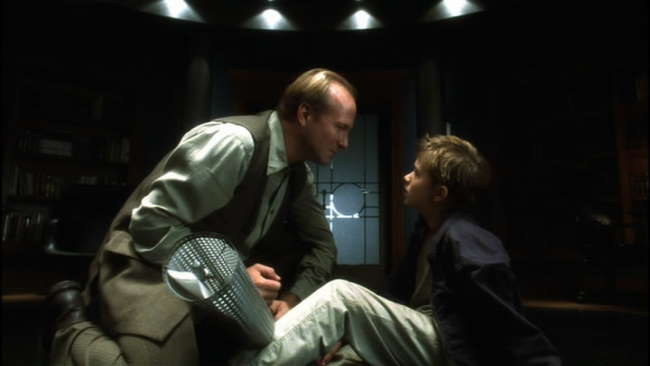
The Bottom Line: AI is a visual feast of dystopia and human morals run amok. As the same time, it’s a beautiful love story about the best of humanity. Many have issues with the ending, although, it works fine for me. While the actions in the Flesh Fair are bit outside believability, overall, the story is very well done. The CG is among the best ever on film (check out page 2 below if you want to see more screencaps). It doesn’t serve to astonish us, but instead, attempts to integrated seemlessly into the film. The acting is terrific, especially from Haley Joel Osment (David the robot boy) and Jude Law (Gigolo Joe). On top of this, we get a very interesting portrayal of a future with sentient robots who do not have any rights. One can almost see the Animatrix’s Rennaissance occurring shortly afterwards.
Go to AI, Page 2: More Screencaps –>>
~See movies similar to this one~
Movie Review By: SFAM
Year: 1995
Directed by: Peter Chung & Howard Baker
Written by: Peter Chung et. al.
IMDB Reference
Degree of Cyberpunk Visuals: Very High
Correlation to Cyberpunk Themes: High
Key Cast Members:
Æon Flux: Denise Poirier (voice)
Trevor Goodchild: John Rafter Lee (voice)
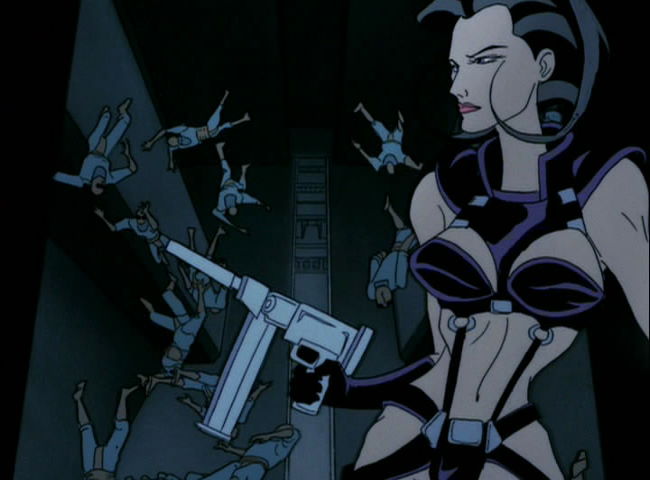
Overview: Aeon-Flux, the brainchild of Peter Chung (also the writer/director of the terrific Animatrix short, “Matriculated”), is one of the really innovative and unique animated shows to come out of the United States. We really have to thank MTV for allowing this show to get produced, and then, after realizing that they just couldn’t control it, for letting it go on unfettered for a second season. Aeon-Flux is not meant to be a coherent whole – this postmodern cyberpunk show is as nihilistic as they come.
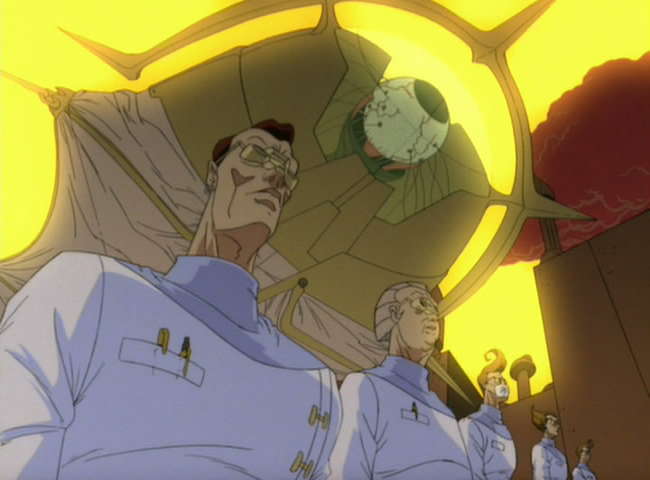
The Story: Aeon Flux takes place in a truly bizarre near-future setting, in which genetic engineering, body modifications, and excessive self-gratification are the norm – yet these extremes take place in a controlled surveillance society. Nearly all events take place in the utopian city, Bregna, which is controlled by a supreme oligarchy. Trevor (voiced by Vampire Hunter D’s John Rafter Lee), one of the two central characters, is a prototypical mad scientist who, at first seems to have little regard for anything other than his own perverted desires. As the show goes on, we find that he is in fact truly besotted with Aeon Flux, who, in many ways is his complete opposite. Aeon Flux (voiced by Denise Poirier) represents the forces of anarchy, and is continually involved in fucking up Trevor’s carefully laid scheming. Unfortunately for Aeon, she too cannot resist Trevor’s guile, which just as often, leads to her downfall.
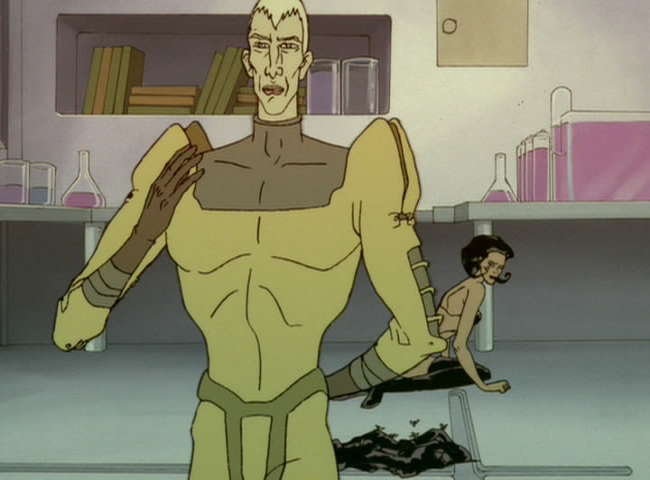
Virtually every episode is different in Aeon Flux, but all of them deal with a strange, fast-paced plot that deals with espionage in some way. Episodes usually have the feel of a chess match, where Aeon and Trevor match wits over completely strange and esoteric plots. More often than not, nobody wins. In fact, unlike most shows, the winning and ending itself is rarely important. This is not what the shows are about. More important is the mood, the feel, and the atmosphere that exudes from the visuals, the dialogue and the score.
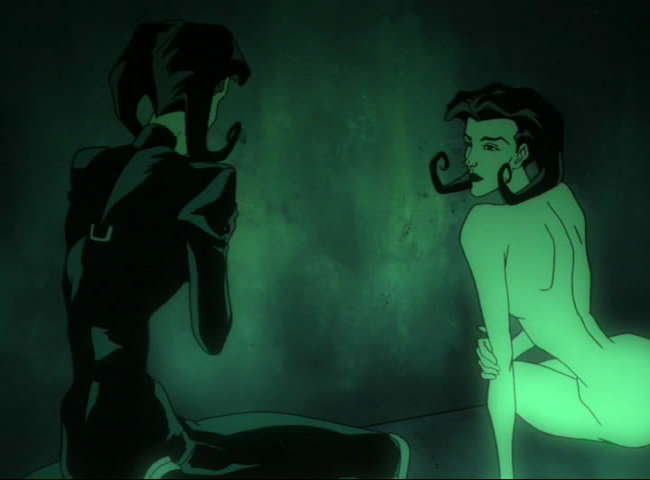
Spoiler – Aeon Flux Dies…A lot! Well, OK, it’s not really a spoiler. It’s more a fact of the show itself. Unlike most shows, in this one, the star dies regularly. Early on in the long shows, Trevor clones Aeon Flux, so thematically, there is now an infinite number of Aeons just waiting to bite the big one. And while there’s now a “rationale” for the deaths, this isn’t really the point – Aeon Flux isn’t meant to hold together that way. It’s almost as if each episode is completely it’s own show. But if she dies, rest assured it will happen in a truly innovative and gruesome way. It could be drowning in a vat of poisen, getting dropped out of a plane, being eating by bizarre genetically modified creatures, or, well, you get the idea. .
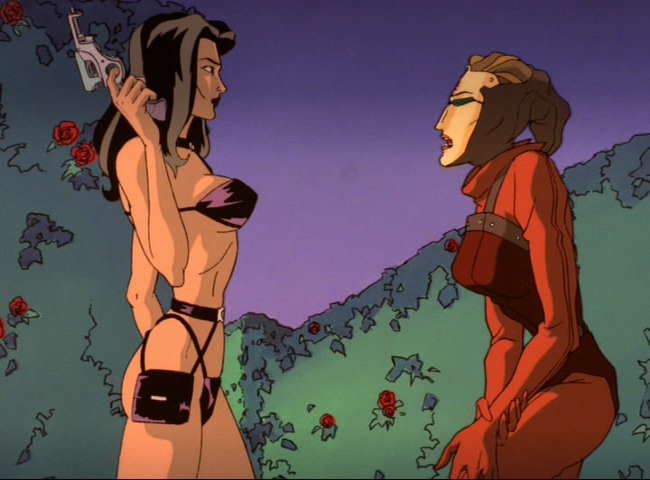
Aeon Flux – the Ultimate Anti-heroine? In many ways, Aeon Flux comes across as the ultimate anti-heroine. While she clearly knows right from wrong, and generally tries to stop the worst abuses, Aeon is an ultra-acrobatic, top-notch action/espionage heroine who works for herself. She’s just as likely to take an assassination job as she is to stop a horrid virus from killing mankind. Did I mention she’s drawn up in ultra-hot, skimpy clothes, and likes to have sex a lot? In this way, she really does qualify as a more female than female character (usually cyberpunk reserves these for cyborgs and androids). Most interestingly, because of Aeon Flux’s propensity for dying, you never know whether or not she’s going to make it through alive, or even whether she’ll complete her mission (she seems to fail almost as much as she succeeds). This really does add an excitement to the episodes.
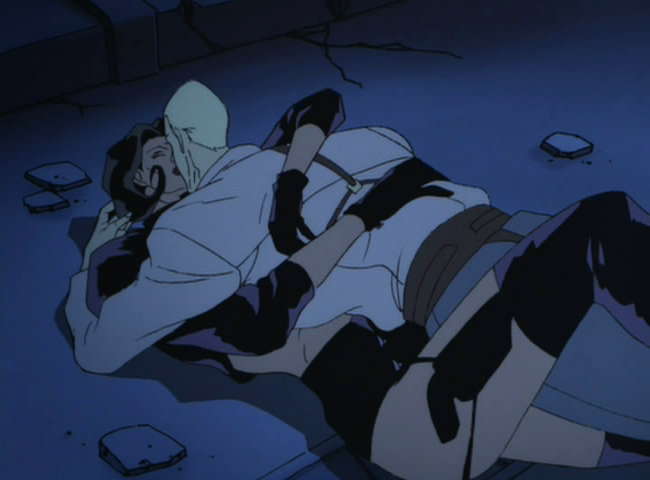
The Love-Hate Relationship: Aeon-Flux and Trevor have a complete love-hate relationship. Even when they are bent on killing one-another, there is always sexual tension, which while often consummated, never leaves the two characters. Every episode gives us yet another chance to explore their relationship in a completely bizarre way. Trevor is definitely Aeon’s Kryptonite. More often than not, his presence alone is enough to make her botch her mission. However, this doesn’t stop Aeon from ruining most, if not all of Trevor’s take over the world plots.
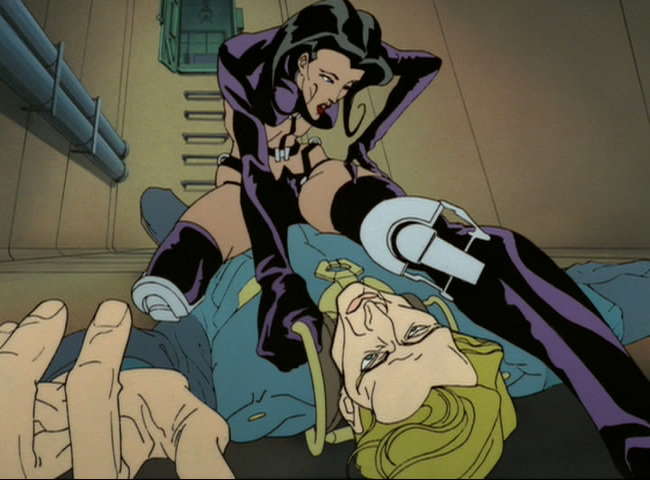
The Visuals and Cinematography: Aeon Flux gives a number of different looks as the show progresses. Perhaps my favorite are the perspective shots such as the one above. We also get lots of wide angle shots, strange close-ups, gradients, and a number of truly surrealistic sets. Unlike most cyberpunk, Aeon Flux doesn’t really adhere to a single dominating color scheme – but to the extent it does, the blues are more highlighted than the rest. Usually, each episode will have a unique theme that dictates the color choices – often they will take a color palette (oranges, greens, etc.) and detail it out in interesting ways. Some episodes are truly surreal in nature, while others are straight neo-noir. The overall goal is always to innovatively create a far-out intense atmosphere wrapped up in a tightly paced, no-nonsense near-future espionage show. More often than not it succeeds.
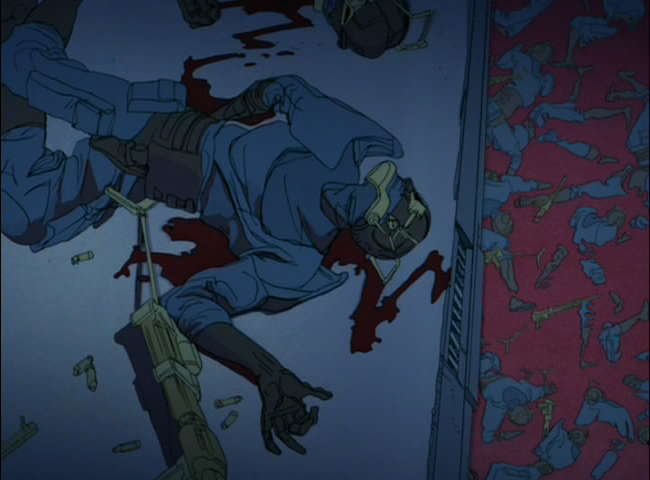
The Violence: Much to MTV’s initial chagrin, Aeon Flux is NOT a kids show. This is an adult cartoon in every way possible, including the intense violence. While the shorts are more violent than the half-hour episodes, Aeon Flux is consistently violent. There are leg amputations, deaths by gunshot, poison, insects, creatures, aliens, viruses, et cetera (often to Aeon herself!). Blood and gore are often just a scene or two away. All of this serves to strengthen the near-future but otherworldly atmosphere of Aeon Flux.
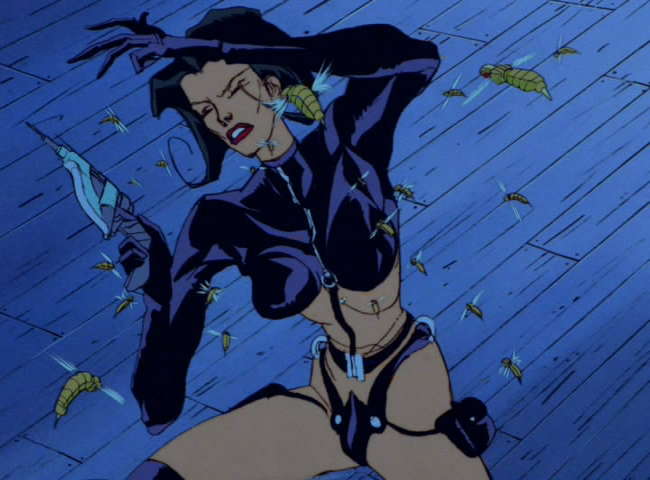
The Gadgets: Aeon-Flux is filled with gadgets of all flavors. Most common are body modifications and “biopunk” elements (just learned that word ). Body modifications include external spinal cord implants, leg jumping implants, conversions of limbs, eye implants, and various compartmentalized bodily storage areas. Genetic engineering is a huge theme in Aeon Flux, far more than the cyber-aspects. We also see repeated instances of cybernetically modified insects who’s function is to inflict a virus of some kind into a target population (Now we know where DARPA got the idea from!). Needles are also a recurring them, and show up everywhere from guns, to security implements, to, um, the operating table.
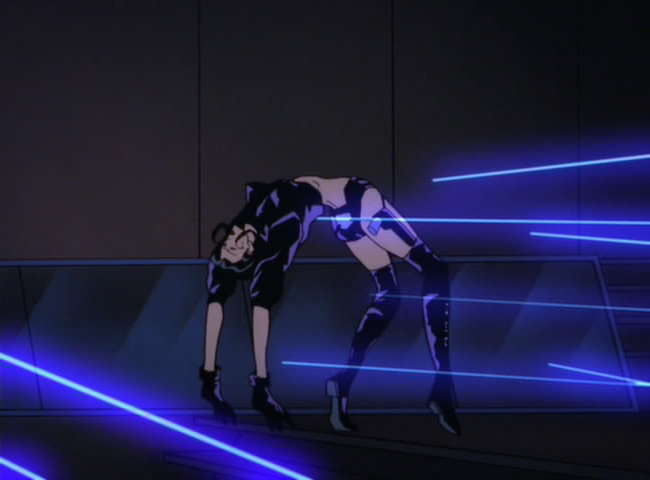
The Bottom Line: Aeon Flux is one of the really creative shows to come out of United States Television. This show validates the purpose of cable TV – we get to see talented folks like Peter Chung let lose their creative energies to produce something truly unique. And while I normally don’t spend too much time talking about the DVD features, I must on Aeon-Flux – the DVD set is flat-out terrific. I almost put it up there with Errol Flynn’s Robin Hood and The Kino edition of Metropolis as one of my favorite DVD productions of a long-lost show. The commentaries, featurettes, and extras are all terrific on the Aeon Flux DVD. If I had any qualms about whether to give Aeon Flux 8 or 9 stars, the incredible quality of the DVD set answers it for me.
More Aeon Flux Screencaps on Page 2–>>
~See movies similar to this one~
Movie Review By: Metatron
Year: 1979
Directed by: Ridley Scott
Written by: Dan O’Bannon & Ronald Shusett
IMDB Reference
Degree of Cyberpunk Visuals: Very High
Correlation to Cyberpunk Themes: Medium
Key Cast Members:
Ripley: Sigourney Weaver
Dallas: Tom Skerrit
Ash: Ian Holm
Kane: John Hurt
Lambert: Veronica Cartwright
Parker: Yaphet Kotto
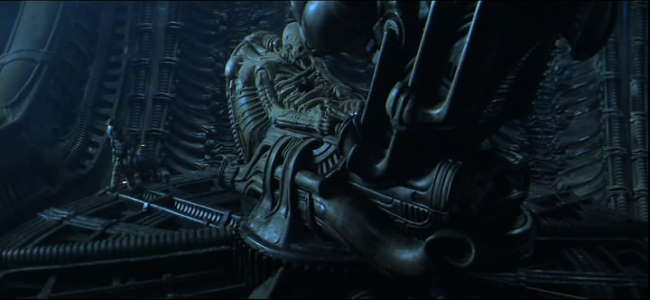
“WHAT’S THE STORY, MOTHER?” Back in 1979, something happened. A momentous event took place, one that would redefine things for years to come, its effects still lingering after all those years. Yet it is neither the none-too-peaceful Soviet meddling in Afghanistan nor the defiant revolt of Iran’s ayatollahs I’m referring to. Something else. A dark vision, a glimpse into the distant void of space. Where no one can hear you scream.
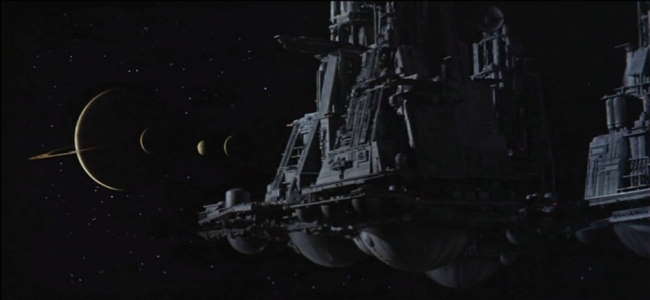
Sure no one could hear ME scream, as it would still be a couple of years before that other great moment in history- the birth of yours truly- but many others sure did when they first saw Ridley Scott’s masterpiece in all its big-screen glory. Must have been one hell of a ride. Another thing I’ve missed then… When I got acquainted with the said macabre flick, it was on a puny twenty-something inch screen and after having seen a multitude of more technologically advanced films. Nevermind. It still blew me away with the force of a 20-megaton nuclear charge. It was something new. An awakening, almost. Don’t ask me how life looked like before Alien. I can’t remember.
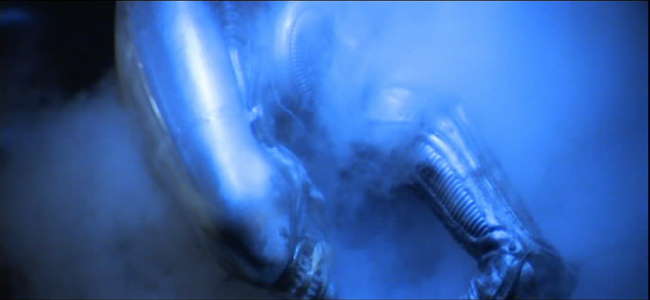
NOT OUR SYSTEM: Okay, so far so good, but there is just one tiny thing. Alien, as the name suggests, is about extraterrestial life. Not of the kind that whooshes past in gaudy flying saucers and abducts cheerleaders, but still very much not of this world. If you think cyberpunk, you obviously think implants, h4×0ring, electric sheep, that sort of thing. Surely a film about a black insect-like monstrosity eviscerating a bunch of interstellar cargo haulers does not fit in here? Well, at the risk of being summarily executed for heresy, I’ll say: yes it does. And, before you get that burning stake ready, I’ll tell you why…
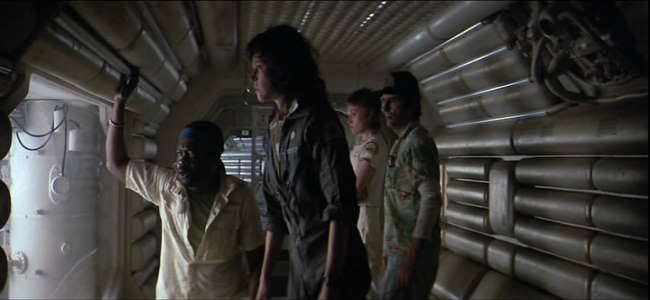
CREW EXPENDABLE: Distant future. USCSS Nostromo, a commercial spacecraft with a gargantuan ore-processing refinery in tow, its 7-man crew in deep hypersleep, encounters an unchartered backyard world from which a mysterious distress signal emanates. Mother, the ships’ computer mainframe, awakens the dreamers- Colonel Ellen T. Ripley among them- to investigate the cryptic transmission, as it is unlikely that its source is anything known to mankind… After landing on the planet’s precambrian surface, the crew discovers a derelict spacecraft… hey, you presumably know all that already anyway! Besides, for those lucky few who are still to live through the cathartic shock that is Alien, I shall try to keep spoilers to a bare minimum. Suffice it to say that they pick SOMETHING up on their unscheduled trip- and this something is just about as friendly to other organic life as H5N1 virus. Only slightly bigger. Needless to say, Colonel Ripley certainly won’t have any good memories from this particular flight…
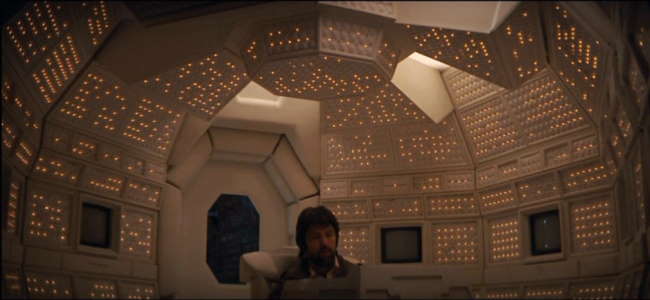
DOES NOT COMPUTE: Now the heretical part. I, regardless of how controversial a view that is, will argue that the original Alien is- you ready for this?- a cyberpunk film. True, it is not PURE cyberpunk in the way the Matrix or Ghost in the Shell are. But then again the vast majority of films reviewed here require some argument as to their cyberpunk credentials. A film does need to have ALL the relevant cyber themes either. Blade Runner and Terminator have no cyberspace, the Matrix has no androids and so forth. Same goes for the visual side. Admittedly, Alien is an uncommon hybrid, a fusion between horror and dark, cyberpunk sci-fi. But this only makes things more interesting.
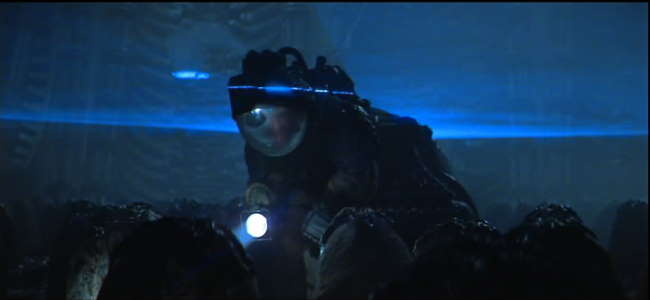
For a start, one needs to mention the existence of a shadowy entity that lurks in the background of the events in Alien (and two of its sequels)- Weyland-Yutani, a dark corporate monolith whose invisible, intangible hand guides many of the events that take place on the Nostromo and beyond. Admittedly, corporate control here is not organized in an oppressive, Orwellian kind of way. Few however would argue that its ruthless actions, removed from any ethical constraints, are any less disturbing. This fictional conglomerate is in fact not far removed from some modern-day corporations that cast aside moral and legal limitations to get what they want. Illegal deals, corruption at the highest level, worker exploitation, illegal drug trials, cover-ups- been watching the news anytime lately? Weyland-Yutani is merely the next step in evolution- a latter-day Wal-Mart, some may say. Not only willing to sacrifice Nostromo’s crew members, it is also quite fine with having its dirty work overseen by a cynical and efficient android, whose cybernetic identity only becomes apparent when a few parts come off…
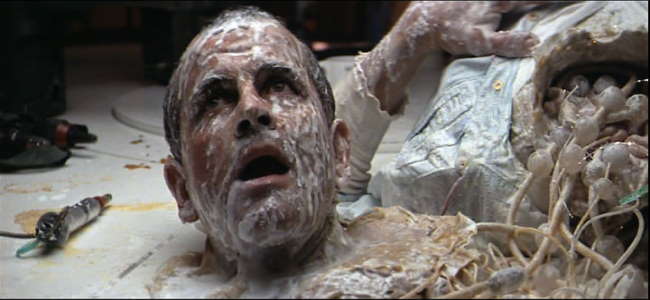
“A GODDAMN ROBOT!”: The inclusion of androids in the Alien series is another overarching cyberpunk theme. The first film does not explore the deeper implications of artificial life as much as the sequels do, but it’s still there. Here, the “artificial person” functions mostly as an extension of Weyland-Yutani’s almost limitless influence, a secretive overseer of affairs who closely follows implanted orders. But the subsequent films will explore this theme further. Rather than merely performing more identity tricks, androids take on a distinct societal role. One might quite correctly remember Bishop and Call, the other synthetics in the series, for their outstandingly vivid humanity, contradicted only by the milky white of their ersatz blood. Yet for all their moral qualities these sentient beings are condemned to an inferior- almost slave-like- role in society. And yet- for now- they accept that role with resignation, tolerating their place in the scheme of things. A programmed limitation? Hardly likely. Given their immensely strong self-awareness, one may imagine how challenging and unfair is it for an entity so humane to accept being treated as nothing more than a piece of property- so much so that Call in Alien Resurrection will at one point voice her defiance and disgust against what she was made to be. By way of comparison, in the first Terminator film the most sophisticated words uttered by our favourite mechanoid executioner are “fuck you, asshole”. See the difference?
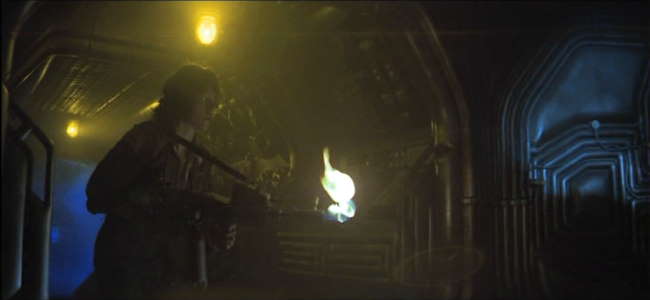
NO FURTHER ENHANCEMENT: The next important bit -the visuals. Powerful, provocative, and atmospheric, they exhibit the studied, gritty realism that has become the calling card of the series. In stark contrast to idealistic visions of the future often seen in other sci-fi films, Alien has gone down a totally different route, one that would later come do be associated with the cyberpunk genre. Case in point- the Nostromo, a far cry from sleek interstellar vessels of old. As it majestically looms into view at the beginning of the film, a mechanical cathedral emerging from the pitch black void, one can see that the film follows an entirely different canon of aesthetics. The ship is monumental, imposing through its sheer mass, intentionally unpretty. Similar approach carries on within, as we explore the craft’s unwelcoming, functional interior of labyrinthine complexity, its dimly lit, grimy corridors filled with snaking wires and exposed machinery. The crew quarters, while cleaner and more organized, seem no less depressing, exhibiting a cold, clinical look reminiscent of vintage computers. Every now and then, the screens will light up with sharply rendered readouts as the mainframes reawaken with eerie electronic chatter. As there was no CGI to fall back against, the only way to create the Nostromo’s vivid interiors was to painstakingly construct the whole set, which gives it a spectacularly tangible quality seldom seen nowadays. And one can almost feel the filmmakers pride, as the camera moves, unhurried, through these cold, industrial catacombs, studying the complex surfaces, celebrating their utilitarian crudity. Along with Blade Runner, this film has defined the core cyberpunk visual reference point for years to come.
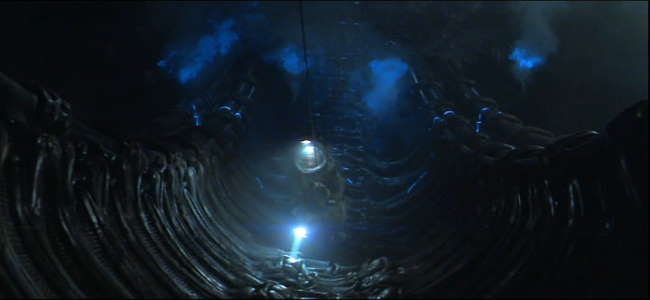
The Nostromo, however, does feel rather cozy next to the primordial desert in which it landed, a dark moonscape filled with surreal forms of bare rock. And it appears positively Arcadian compared to the infamous derelict ship, a bizarre structure, part mechanical, part organic, an otherworldly nightmare. Welcome to the dreamworld of H.R. Giger…
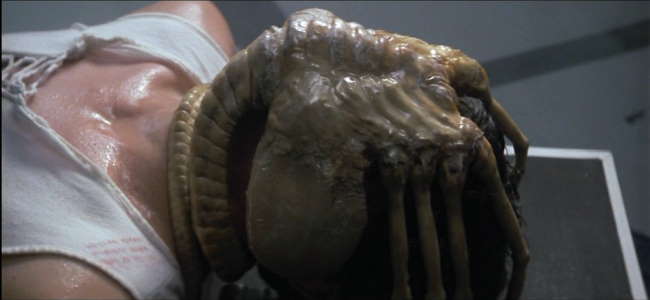
PERFECT ORGANISM: Often imitated and never bettered, Giger is a master of the grotesque. It is his wonderfully twisted mind that has spawned what is probably the greatest creature designs ever. Yet the Xenomorph is only one of Giger’s many dark, disturbing visions- many of which have caused outbreaks of controversy due to their blatant, twisted eroticism. Indeed, much of the Alien’s looks and life cycle can be seen as a perverse sexual metaphor. Yet Giger’s art is first and foremost a study of a peculiar symbiosis between man and machine, an often perverse fusion of the robotic and the organic. Next to his biomechanical mutations, most depiction of cyborg flesh appear staid and conservative. Some theories about the Xenomorph itself in fact suggest that its obscene, insectoid form was not a result of evolution, but deliberate design, the entire species intended for use as the ultimate bioweapon by a mysterious extraterrestrial race to which the forsaken spacecraft belonged. In that respect, it seems to blur the line between biological and artificial life, being something of an organic killing machine. And, it has to be added, a pretty effective one at that.
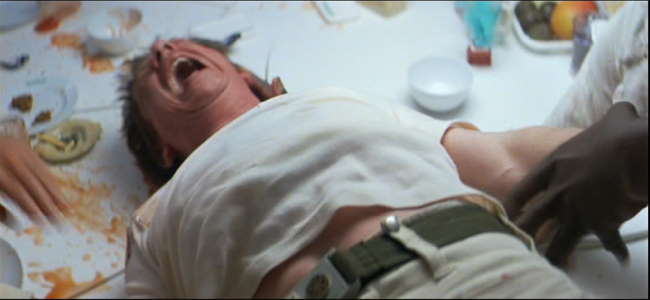
HEAR THEM SCREAM: The sound effects complete the package. From the moody, unmistakable musical score by Jerry Goldsmith to the sonic assault that we are treated to in the final sequences, as self-destruct alerts moan mournfully and explosions fill the air, this is a true masterpiece. The sound effects also have definite cyberpunk traits- the strange bleeps and machine chatter generated by the ship’s electronics are one of the best I’ve ever heard. And the Alien shrieks are almost music to my ears…
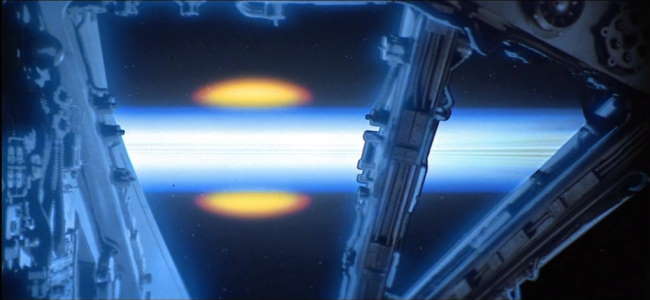
SIGNING OFF: Ripley’s confrontation with the Alien would not, of course, be the last. Three sequels have followed, each surprisingly managing to explore new themes, many of which have strong relations to the cyberpunk movement as well. Rumours of a fifth installment still linger, even though the outstanding flop that is AVP has cooled some of the enthusiasm down, and Weaver, whose evolution from a scared little girl into a seasoned Xenomorph slayer was one of the major aspects of the film, has denied involvement. We shall see. Whatever its future may be, the Alien franchise has often been seen as sitting uneasily among the more obvious cyberpunk films. Being a hybrid, it was bound be frowned upon by the purists. Yet the mere fact that it involved some non-cyber themes made many ignore the fact that it had loads of thematic links to the genre, plus its visual side is arguably closer to the orthodox cyberpunk ideal than Equilibrium, Casshern and Dark City taken together. And that it was made by the very same man who brought us a certain film involving runaway replicants. In fact the series came painfully close to gaining a sort of blessing from William Gibson himself, who has produced the original script for the third Alien film- one that, for some bizarre reason, got rejected. If it succeeded, the perception of the franchise in terms of its cyberpunk credibility might have been very different indeed.
And now if you excuse me, I’m off for a heresy trial…
More Alien Screencaps on Page 2–>>
~See movies similar to this one~
Year: 1990
Directed by: Paul Verhoeven
Written by: Philip K. Dick (story), Ronald Shusett, Dan O’Bannon et al.
IMDB Reference
Degree of Cyberpunk Visuals: High
Correlation to Cyberpunk Themes: High
Key Cast Members:
Douglas Quaid/Hauser: Arnold Schwarzenegger
Melina: Rachel Ticotin
Lori: Sharon Stone
Richter: Michael Ironside
George/Kuato: Marshall Bell
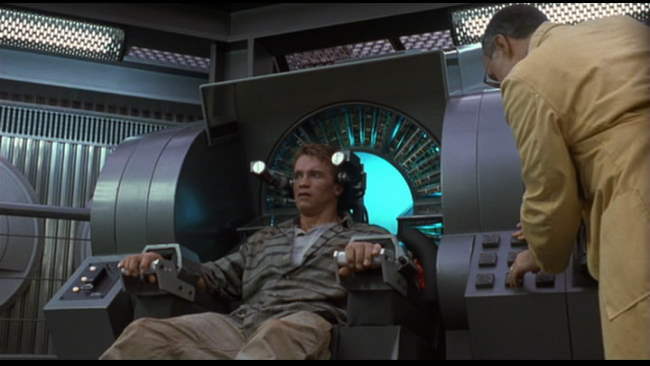
We can remember it for you wholesale!
Overview: Total Recall is one of the better known cyberpunk movies from the late 80s to early 90s. This is cyberpunk all the way with intense memory modification, a dystopic future, and malformed humans of all styles. The visuals are sometimes cheesy, but always pretty fun, and include various shots like a 3-breasted woman, exploding heads, bulging eyes, and this guy below. This is one of Arnold’s better roles, although the story does tend to rely on a continual stream of head-jerking mind fucks.
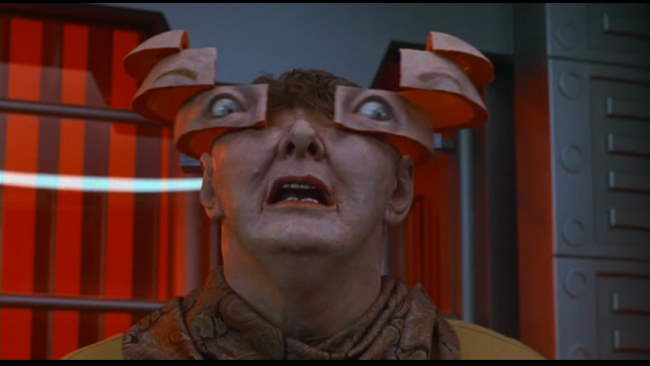
Taken from Philip K. Dick’s story, “We Can Remember it for You Wholesale,” Total Recall stars Arnold Schwarzenegger as an everyday man, Douglas Quaid, who craves something different in his life. He keeps on having realistic dreams about Mars and decides to visit Mars virtually. He goes to “the Recall Corporation” to get some memories manufactured and installed - ones that are exciting, and speak of Mars, espionage and slutty, athletic women!

Unfortunately, things go very wrong. In the process of getting his new memories installed, he wakes up to find that things are not as they seem – in fact he doesn’t know if he woke up at all, or if whether he’s still experiencing a memory impact at the Total Recall Corporation. Things get weirder and weirder, and involve a trip to Mars, and sleazy corporate plots.

Total Recall gets Arnold to truly stretch his emotion capabilities, as we get to see him act in ways he really hasn’t done elsewhere. The rest of the cast isn’t exceptional, but puts in serviceable performances. Rachel Ticotin (the slutty athletic chick), Sharon Stone (Douglas’s wife, or maybe not), Ronny Cox (the evil corporate dude) and Michael Ironside (The evil right hand guy) all provide us with memorable characters.
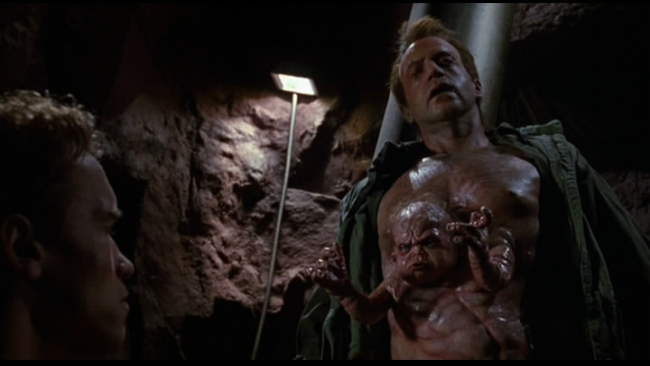
The Bottom Line: All in all, Total Recall is not the greatest movie ever, and has some significant science issues and plot holes, but it’s a truly fun ride with lots of replay potential. It does the memory modification thing very well, and while you get your head jerked around a bit, overall, the plot works.
~See movies similar to this one~
Year: 1982
Directed by: Slava Tsukerman
Written by: Anne Carlisle, Nina V. Kerova & Slava Tsukerman
IMDB Reference
Degree of Cyberpunk Visuals: Medium
Correlation to Cyberpunk Themes: Very Low
Key Cast Members:
Margaret/Jimmy: Anne Carlisle
Johann Hoffman the Scientist: Otto von Wernherr
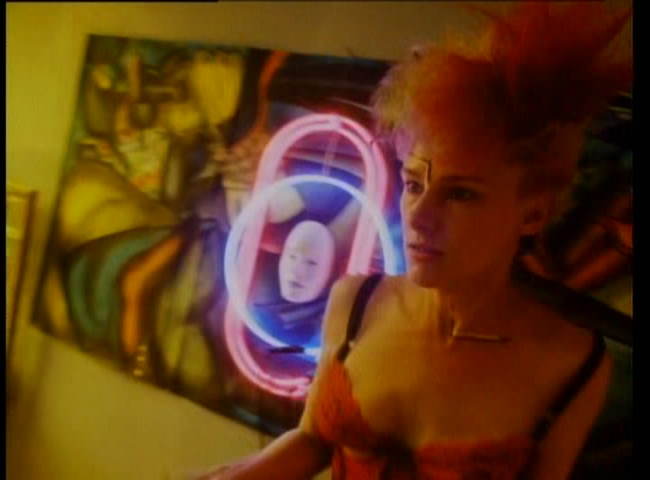
Overview: Liquid Sky is another movie that makes a number of cyberpunk lists. Personally, I don’t think so. It has absolutely NO cyber aspects (it does have scifi aspects though). However, it’s so strong on the punk side that from a visual standpoint I suppose a case can be made for inclusion. This is a very low-budget art film that is emphasizes “weird” from the get go. If I were to rename it, I would call this “The movie where the Punks say Fuck!” as they do so every other word. The real effort here is NOT in the acting (most is horrible, but Carlisle is decent), or the story, or the pacing. The goal is to create a weird punk immersion that gives the film an other-worldly quality. This is emphasized by the completely non-sensical alien pie-plate spaceship.
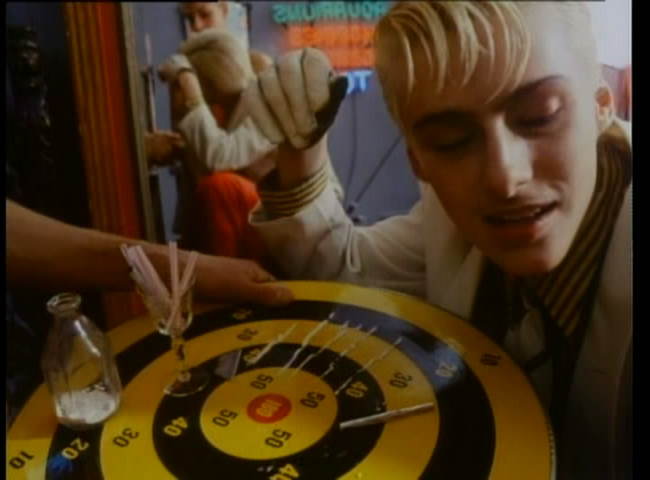
Liquid Sky takes place in modern times (early 1980s) where a very small alien space ship is looking for a heroin fix and settles on top of a punk-apartment building where drug addicts are the order of the moment. The space ship “steals” the emotional state of the heroin addicts to give itself energy. We soon find out that the aliens can also get their fix from people having orgasms. In line with this, the aliens follow around Margaret (played by Liquid Sky writer, Anne Carlisle, who also plays the role of the androgynous Jimmy in the picture above), who is continually getting raped and forced into having sex with people she doesn’t like. She never orgasms, but her partners always do. At first, the aliens appear to steal this energy by impaling the victims with a crystal scepter, but later, the victims just disappear. Anne starts to think her vagina has the power to kill, and either tries to stop having sex with people she likes (which fails) or seeks out those she hates in order to kill them. All the while, a European scientist, who’s big on the narration (this is the only way we learn what’s going on) is tracking down the alien ship and is attempting to warn the punks.
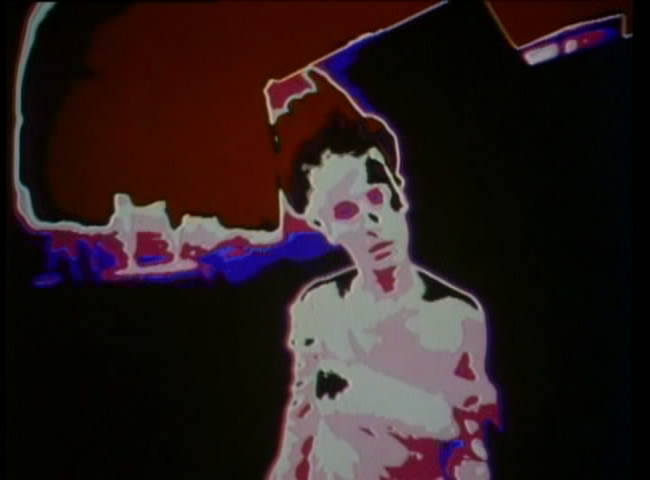
Overview: This movie is a massive cheesefest in every sense of the word. It is quirky enough to be interesting though (hence the 5 stars instead of 4), and is certainly original to the point that I could certainly imagine some enjoying this multiple times. Again, for the moment I’ve decided to include it as a cyberpunk flick, but I’m sorely tempted to move it to the “not cyberpunk” category. Even though the visuals qualify in a strange way, there is no cyberpunk themes to speak of here.
~See movies similar to this one~
Tags: cyberpunk movie review LiquidSky
|



















































































